Introduction
Reproduced below is the raw feed of obituaries for Robert Ettinger. There are many more, most repetitive and based on the same primary sources (i.e., news services and THE WASHINGTON POST). Examining a representative of the raw feed is instructive because local news outlets will frequently cut, edit, or add to their primary source and they will also impact public perception of the story by how they title and illustrate it. What follows is thus an attempt to capture the quality and quantity of the regional coverage of Robert Ettinger’s cryopreservation. – Mike Darwin
THE DETROIT NEWS
Last Updated: July 26. 2011 1:00AM
Ettinger, father of cryonics movement, dies; placed in deep freeze
Kim Kozlowski/ The Detroit News
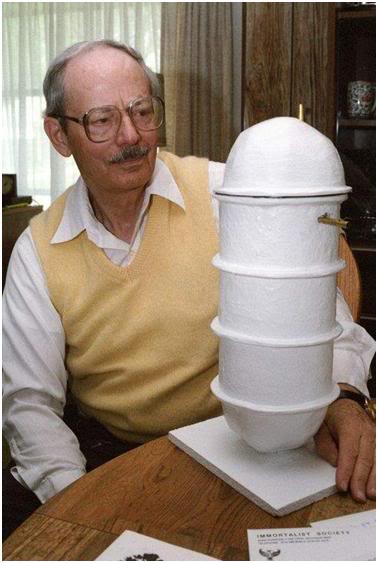 Robert Ettinger devoted his life to providing an option that could possibly lead to eternal life with the help of science.
Robert Ettinger devoted his life to providing an option that could possibly lead to eternal life with the help of science.
But that type of science had yet to evolve when he died over the weekend.
So the body of the man whom many hail as the father of the cryonics movement on Monday was being prepared for storage in a liquid nitrogen tank in Clinton Township beside 100 others who shared his views. His hope: future technology will resurrect him, cure what ailed him and give him everlasting life.
“I am very sad about it,” said his son, David Ettinger. “But at the same time, the nice thing about cryonics is that hopefully I will see him again one day.”
Ettinger, 92, became the 106th patient at the organization he founded 35 years ago, the Cryonics Institute. Only one other major cryonics facility exists in the world.
The five-day process for preparing Ettinger’s body involved packing it on ice, perfusing it with chemicals to limit freezer damage and slowly cooling it to the temperature of liquid nitrogen. It began within minutes of his death on Saturday afternoon, his son said, to assure the least amount of damage. He is expected to be submerged upside down in a tank, known as a cryostat, filled with liquid nitrogen by Thursday.
Those who were inspired by Ettinger said he leaves behind a profound mark.
“Bob Ettinger inspired at least two generations of young visionaries to consider humanity’s long-term future and their place in it with a level of rationality that had rarely been applied to that topic hitherto,” said Aubrey de Grey, chief science officer of the SENS Foundation, which is working to advance rejuvenation therapies. “He showed us that cryonics makes sense. … Until he benefits personally from his vision, he will be sadly missed.”
Ettinger was 14 when he read a science fiction story that spawned cryonics. The story, “The Jameson Satellite,” relayed how a professor sent a corpse into Earth’s orbit for indefinite preservation. Millions of years later, aliens found the body, took the brain out and put it in a mechanical body. Ettinger thought the author missed the point of his own story.
“Why wait for aliens?” Ettinger told The Detroit News in 2009. “Why not do it ourselves?”
Ettinger served in World War II, where he was injured in Germany. He spent months in the hospital and discovered science was accelerating the concept of cryonics.
He self-published a book in 1962: “The Prospect of Immortality.” Two years later, Doubleday published the book, which was eventually translated into several languages.
“I thought the premise was so logical,” said Ettinger, who taught physics and math at Wayne State University and Highland Park Community College.
He founded the Cryonics Institute in 1976, first located in Detroit. For years, membership was in the single digits, but it has grown to more than 900 people from around the globe. All want either to preserve themselves, DNA or pets.
Ettinger joins his mother, Rhea Ettinger — who was the first cryopreserved corpse at the institute, in 1977 — and his first and second wives, Elaine and Mae Ettinger, the institute’s No. 2 and 34 patients, respectively.
kkozlowski@detnews.com
(313) 222-2024
From The Detroit News: http://detnews.com/article/20110726/OBITUARIES/107260364/Ettinger–father-of-cryonics-movement–dies–placed-in-deep-freeze#ixzz1TFZeYchG
————————————
DAILY MAIL (London, UK)
Frozen in time: ‘Father of Cryonics’ entombed at -321F after dying aged 92
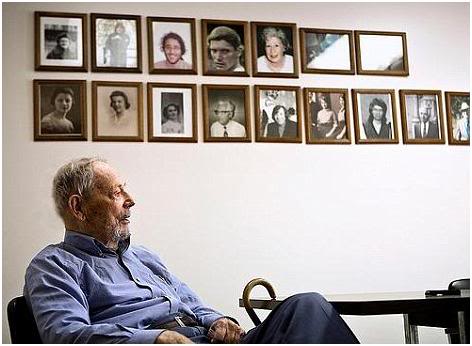 Body of Robert Ettinger committed to his own institute
Body of Robert Ettinger committed to his own institute
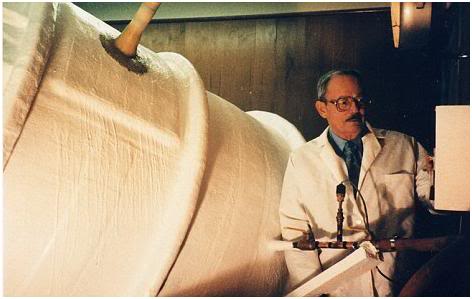 Placed alongside his mother and two wives
Placed alongside his mother and two wives
By Daily Mail Reporter
Last updated at 1:47 PM on 26th July 2011
• Comments (19)
A pioneer of the cryonics movement which advocates freezing the dead in the hope that medical technology will enable them to live again in the future has died at the age of 92.
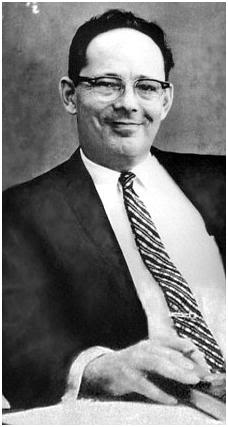 Robert Ettinger, from Clinton Township, Detroit, became the 106th person to be stored at the Cryonics Institute which he founded in 1976.
Robert Ettinger, from Clinton Township, Detroit, became the 106th person to be stored at the Cryonics Institute which he founded in 1976.
The World War Two veteran, who taught physics at Wayne State University, was seriously wounded during the Battle of the Bulge and spent years in hospitals.
Legacy: Robert Ettinger, 92, has been frozen in the Cryonics Institute he founded after his death.

High tech: The institute, in Detroit, Michigan, already has Mr Ettinger’s mother and two wives as patients
Bone graft surgery that saved his legs inspired his optimism about the future prospects of preserving life through technology, a statement from the Cryonics Institute said.
His son David Ettinger said he had been inspired by science fiction writings about deep-freezing the dead and expected researchers to make serious progress toward developing the idea.
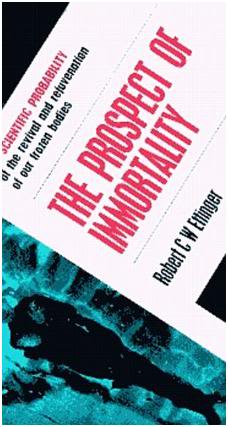 But when nothing seemed to be happening, he wrote a book in 1964 entitled ‘The Prospect Of Immortality’, introducing the concept of cryonics.
But when nothing seemed to be happening, he wrote a book in 1964 entitled ‘The Prospect Of Immortality’, introducing the concept of cryonics.
He wrote: ‘If civilisation endures, medical science should eventually be able to repair almost any damage to the human body, including freezing damage and senile debility or other cause of death.’
‘Sooner or later our friends of the future should be equal to the task of reviving and curing us,’ said Ettinger
Optimist: Mr Ettinger was inspired by successful bone graft surgery he underwent after being injured during World War Two. Right, the 1964 book he wrote in which he introduced the idea of freezing humans after death
BROUGHT BACK TO LIFE
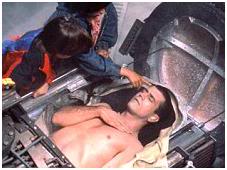 Cryonics is the low-temperature preservation of humans and animals with the hope that they will be able to be ‘brought back to life’ when science is able to do so.
Cryonics is the low-temperature preservation of humans and animals with the hope that they will be able to be ‘brought back to life’ when science is able to do so.
It is often confused with cryogenics, the study of the production of very low temperatures and how materials react to them.
The procedure has to be begun within minutes of cardiac arrest. Cryoprotectants are used to prevent ice crystals forming between body cells, which would then cause irreparable damage if the victim was then ‘thawed’.
The belief is that memories and identity could survive the freezing process.
Only around 200 people have been preserved cryonically since it was first proposed in 1962.
Films featuring cryonics include Woody Allen’s 1973 Sleeper, James Cameron’s Aliens in 1986 and the 1992 movie Forever Young, starring Mel Gibson (pictured).
He added: ‘No matter what kills us, whether old age or disease, and even if freezing techniques are still crude when we die, sooner or later our friends of the future should be equal to the task of reviving and curing us.’
Mr Ettinger promoted his theory in other writings and appearances on television talk shows.
The Cryonics Institute has 900 members. Similar facilities for preserving dead bodies operate in Arizona, California and Russia.
He also established the Immortalist Society, a research and education group devoted to cryonics and extending the human life span.
The institute charged $28,000 to prepare a body and store it long-term in a tank of liquid nitrogen at minus 321 degrees Fahrenheit.
The first person frozen there was Mr Ettinger’s mother, Rhea Ettinger, who died in 1977.
Both his wives, Elaine and Mae, are also patients at the institute.
His son said he was never bothered by ridicule and was a ‘reluctant prophet’.
‘He did what he thought was necessary and appropriate and didn’t worry much about what people thought,’ he said.
‘The people who are scoffers are like the people who said heavier-than-air flight won’t work.’
Robert Ettinger died at his home in Detroit after weeks of declining health.
Read more: http://www.dailymail.co.uk/news/article-2018628/Pioneer-cryonics-movement-92-body-frozen-institute-death.html#ixzz1TFa8WYRI
————————————
NEW KERLA NEWS (Melbourne, AU)
Process to freeze dead body of father of cryonics Robert Ettinger starts
Melbourne, July 26 : The body of late Robert Ettinger, who is known as the father of the cryonics movement, is currently undergoing a five-day process to cool it for storage at a very low temperature.
According to the Detroit News, Ettinger, who died July 23 at the age of 92, will become the 106th patient at the organisation he founded, the Cryonics Institute, in Clinton Township, Michigan.
Once there, he will join his mother, who was the first cryo-preserved corpse at the institute in 1977, and his first and second wives, who were numbers two and 34 respectively.
The paper said Ettinger did not want a memorial service because he believed he may return.
The five-day process to preserve Ettinger’s body began within minutes of his death and involved packing the body on ice, using chemicals to limit freezer damage and slowly cooling it to the temperature of liquid nitrogen.
It quoted his son, David, as saying the body was expected to be ready to be submerged upside down in a liquid nitrogen filled tank by July 28.
“He really has been viewed as the inspirational leader of the cryonics movement, and thousands of people around the world have looked up to him and will be upset that’s gone but hopeful that he will be back,” News.com.au quoted David as saying.
–ANI
Read More: http://www.newkerala.com/news/2011/worldnews-35581.html
————————————
KYIVPOST.COM
Cryonics pioneer Robert Ettinger dies, body frozen
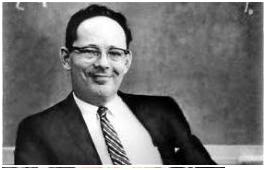 Robert Ettinger, pioneer of the cryonics movement
Robert Ettinger, pioneer of the cryonics movement
Yesterday at 12:22 | Associated Press
TRAVERSE CITY, Michigan (AP) — Robert Ettinger, pioneer of the cryonics movement that advocates freezing the dead in the hope that medical technology will enable them to live again someday, has died. He was 92.
Ettinger died Saturday at home in the Detroit suburb of Clinton Township after weeks of declining health, son David Ettinger said.
His body became the 106th to be stored at the Cryonics Institute, which he founded in 1976.
“My father devoted himself to doing what he could to enable his family, his friends and others to come back and live again,” David Ettinger told The Associated Press. “Whether he will achieve that nobody knows at this point, but we think he has a good shot.”
Robert Ettinger, who taught physics at Wayne State University, was seriously wounded during the Battle of the Bulge in World War II and spent years in hospitals.
The bone graft surgery that spared his legs inspired his optimism about the future prospects of preserving life through technology, a Cryonics Institute statement said.
His son said Ettinger also was inspired by science fiction writings about deep-freezing the dead and expected researchers to make serious progress toward developing the idea.
But when nothing seemed to be happening, he wrote a 1964 book, “The Prospect of Immortality,” introducing the concept of cryonics.
“If civilization endures, medical science should eventually be able to repair almost any damage to the human body,” he wrote, “including freezing damage and senile debility or other cause of death.”
He added: “No matter what kills us, whether old age or disease, and even if freezing techniques are still crude when we die, sooner or later our friends of the future should be equal to the task of reviving and curing us.”
Ettinger promoted his theory in other writings and appearances on television talk shows.
The Cryonics Institute has 900 members. Similar facilities for preserving dead bodies operate in Arizona, California and Russia.
Ettinger also established the Immortalist Society, a research and education group devoted to cryonics and extending the human life span.
The Cryonics Institute charges $28,000 to prepare a body and store it long-term in a tank of liquid nitrogen at minus 321 degrees Fahrenheit.
The first person frozen there was Ettinger’s mother, Rhea Ettinger, who died in 1977. His two wives, Elaine and Mae, also are patients at the Institute.
Ettinger was never bothered by ridicule and was a “reluctant prophet,” his son said.
“He did what he thought was necessary and appropriate and didn’t worry much about what people thought,” David Ettinger said. “The people who are scoffers are like the people who said heavier-than-air flight won’t work.”
Read more: http://www.kyivpost.com/news/world/detail/109397/#ixzz1TFb2u9yV
————————————
UPI
U.S. News
Cryonics pioneer Ettinger dead at 92
Published: July 26, 2011 at 2:49 AM
CLINTON TOWNSHIP, Mich., July 26 (UPI) — Robert Ettinger, who pioneered cryonics — the idea of freezing people’s bodies to be resurrected in the future, has died in Michigan at 92, his family said.
His son David told the Michigan news Web site MLive.com his father died Saturday at his home in Clinton Township. The Detroit News reported he died of respiratory failure.
Robert Ettinger was an early proponent of storing people’s bodies at very low temperature after death in hopes that future technology would allow for revival and curing of aging and disease.
Appropriately, upon his death he became the 106th person to go through the process at the organization he founded, the Cryonics Institute, the News said.
Over a period of five days, Ettinger’s body was being slowly cooled to the temperature of liquid nitrogen, and by Thursday is expected to be ready to be submerged upside down in a tank filled with liquid nitrogen, his son said.
“He really has been viewed as the inspirational leader of the cryonics movement, and thousands of people around the world have looked up to him and will be upset that’s [he's] gone but hopeful that he will be back,” David Ettinger said.
Robert Ettinger had said he was inspired in his effort by reading the science fiction story “The Jameson Satellite” when he was 14 years old, the News said.
David Ettinger said his father, a former Wayne State University physics professor, believed in taking facts and logic “and see where it leads you,” MLive.com said.
“Hopefully it leads us to see him again,” he said.
© 2011 United Press International, Inc. All Rights Reserved. Any reproduction, republication, redistribution and/or modification of any UPI content is expressly prohibited without UPI’s prior written consent.
Read more: http://www.upi.com/Top_News/US/2011/07/26/Cryonics-pioneer-Ettinger-dead-at-92/UPI-70501311662990/#ixzz1TFbPYARV
————————————
TEXARKANA GAZETTE
Founder of Cryonics Institute Robert Ettinger dies, body frozen
By: Associated Press – Texarkana Gazette
TRAVERSE CITY, Mich.—Robert Ettinger, pioneer of the cryonics movement that advocates freezing the dead in the hope that medical technology will enable them to live again someday, has died. He was 92.
Ettinger died Saturday at home in the Detroit suburb of Clinton Township after…
Published: 07/26/2011
————————————
NEW SCIENTIST
Dead cryonics founder is frozen as planned
22:37 25 July 2011
Health
Science In Society
Ferris Jabr, reporter
 Ettinger (right) entertains visitors (Image: Cryonics Institute)
Ettinger (right) entertains visitors (Image: Cryonics Institute)
In Clinton Township, Michigan, in what looks like just another drab office building, more than 100 people float peacefully inside giant bottles filled with liquid nitrogen. Before they died they asked the Cryonics Institute to freeze them in the hopes that one day doctors will have technology to revive them.
Robert Ettinger, founder of the cryonics movement, has finally become a human popsicle himself after dying on 23 July from unspecified causes following weeks of declining health. The 92-year-old joins his mother, Rhea, his first wife, Elaine, and his second wife, Mae, who were all cryopreserved at the Cryonics Institute as well. The minimum price tag: $28,000.
Other organisations charge upwards of $200,000 and offer the option of “neuropreservation”: instead of freezing their whole bodies, clients freeze only their heads. The idea is that one’s personality and memories will be preserved in the brain and could be uploaded to a computer or artificial body in the future.
Ettinger was inspired by the Neil Jones short-story “The Jameson Satellite,” which tells of a professor who has his corpse launched into space, where – millions of years later – a race of robotic men resuscitate the professor by transplanting his brain into a mechanical body. The work of French biologist Jean Rostand, who froze and defrosted frog sperm without serious damage, also enthused Ettinger.
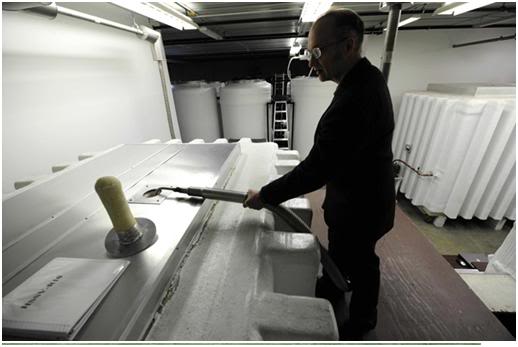 (Image: Sipa Press/Rex Features)
(Image: Sipa Press/Rex Features)
No one really knows whether we can ever return consciousness to frozen corpses, but cryopreservation is a genuine phenomenon in the animal kingdom and a useful technique in medicine.
 Many living animals have evolved tricks to survive sub-zero temperatures and thaw out after temporary periods of icy paralysis. And scientists have made significant headway in freezing living tissues and even whole human organs for medical purposes. To the disappointment of Jurassic Park fans and enthusiasts of prehistoric life, the notion of resurrecting a frozen mammoth has not panned out so far.
Many living animals have evolved tricks to survive sub-zero temperatures and thaw out after temporary periods of icy paralysis. And scientists have made significant headway in freezing living tissues and even whole human organs for medical purposes. To the disappointment of Jurassic Park fans and enthusiasts of prehistoric life, the notion of resurrecting a frozen mammoth has not panned out so far.
Other people who have been cryonically preserved include American baseball player and manager Ted Williams and his son John Henry Williams, University of California psychology professor James Bedford and mathematician Thomas Donaldson.
————————————
THE ATLANTIC
Cryonics Founder Dies, Now Patiently Awaiting His Comeback
By Rebecca J. Rosen
Jul 26 2011, 4:47 PM ET 2
Robert Ettinger, 1918-2011?
Cryonics Institute
Ettinger is now frozen in a facility in Michigan along with his two wives. “If both of my wives are revived,” he said, “that will be a high class problem.”
Over the weekend, Robert Ettinger, founder of the cryonics movement, died at his home in Michigan and was quickly frozen. “We’re obviously sad,” said his son David in an obituary in The Washington Post. But “we were able to freeze him under optimum conditions, so he’s got another chance.”
For the uninitiated: Cryonics is the preservation of dead people — “patients” in cryonics-speak — at very low temperatures in preparation for a time when medical advances allow them to be thawed and brought back to life. At the top of the page, take a look at the facilities, machines, and people that are working to keep more than 100 people and several dozen animals frozen in the suburbs of Detroit.
A dream of a world where death can be undone raises some nasty ethical problems, but cryonicists are not to be deterred. In a New Yorker profile of Ettinger two years ago (subscription required), Jill Lepore wrote:
But if no one ever dies, won’t there be too many people on the planet? “The people could simply agree to share the available space in shifts, Ettinger suggested, “going into suspended animation from time to time to make room for others.” There will be no childbirth. Fetuses will be incubated in jars. “Essentially, motherhood will be abolished.” Then, too, eugenics will help keep the birthrate down, and deformed babies could be frozen against the day that someone might actually want them, or figure out how to fix them. “Cretins,” for instance, or babies born with cerebral palsy. For the weak-minded, who might find making such a decision difficult, Ettinger offered a philosophical rule of thumb: Ask yourself, “If the child were already frozen and it were within my power to return him to deformed life, would I do so? If the answer is negative, then probably the freezer is where he belongs.”
Regardless of your position on the movement’s moral standing or the odds you’d give of anyone ever being revived, it is clear that cryonics presents an immense technological challenge. How do you freeze a body for hundreds of years? Machines break, electricity fails, people shirk their responsibilities. If a body warms up, even for a short while, decomposition will set in and any hope of awakening will be dashed. (For a fantastic look at the difficulties faced when trying to keep bodies frozen, check out this episode of This American Life.)
————————————
THE AGE.COM.AU
Cryonics pioneer is coolly waiting for second chance
John Flesher
July 27, 2011
In storage … Robert Ettinger.
TRAVERSE CITY, Michigan: Robert Ettinger, pioneer of the cryonics movement that advocates freezing the dead in the hope that medical technology will enable them to live again, has died. He was 92.
Mr Ettinger died on Saturday at home in Detroit after weeks of declining health, his son, David Ettinger, said. His body has become the 106th to be stored at the Cryonics Institute, which he founded in 1976.
”My father devoted himself to doing what he could to enable his family, his friends and others to come back and live again,” David Ettinger said. ”Whether he will achieve that nobody knows at this point but we think he has a good shot.”
Advertisement: Story continues below
Robert Ettinger, who taught physics at Wayne State University, was seriously wounded during the Battle of the Bulge in World War II and spent years in hospitals. The bone graft surgery that spared his legs inspired his optimism about the prospects of preserving life through technology, a Cryonics Institute statement said.
His son said Mr Ettinger also was inspired by science fiction writings about deep-freezing the dead and expected researchers to make serious progress towards developing the idea. But when nothing seemed to be happening, he wrote a book in 1964 called The Prospect of Immortality, introducing the concept of cryonics.
”If civilisation endures, medical science should eventually be able to repair almost any damage to the human body,” he wrote, ”including freezing damage and senile debility or other cause of death.”
The institute charges $US28,000 ($25,890) to prepare a body and store it long term in a tank of liquid nitrogen at minus 160 degrees. The first person frozen there was Mr Ettinger’s mother, Rhea, who died in 1977. His two wives, Elaine and Mae, are also held by the institute.
David Ettinger said his father was a ”reluctant prophet”. ”He did what he thought was necessary and appropriate and didn’t worry much about what people thought … Scoffers are like the people who said heavier-than-air flight won’t work.”
Associated Press
Read more: http://www.smh.com.au/world/cryonics-pioneer-is-coolly-waiting-for-second-chance-20110726-1hymi.html#ixzz1TFciv96e
————————————
THE GUARDIAN UK
Would you want to be brought back to life after death?
 Tuesday 26 July 2011 14.44 BST
Tuesday 26 July 2011 14.44 BST
Robert Ettinger, a pioneer of the cryonics movement, has died and had his body stored in a tank of liquid nitrogen, in the hope that medical technology may one day bring him back to life. If Ettinger’s technology worked, would you be tempted to have yourself laid to rest in a deep-freezer?
1.
1. Yes
2. No
Cryonics pioneer Robert Ettinger dies
Ettinger’s body is frozen in liquid nitrogen and stored at the institute he founded, along with those of his mother and wives
Robert Ettinger, a pioneer of the cryonics movement, has died and had his body stored at the facility he founded in the hope that medical technology will enable him to live again one day.
Ettinger died at home on Saturday, aged 92, in a suburb of Detroit after weeks of declining health. His body became the 106th to be frozen and stored at the Cryonics Institute, which he founded in 1976.
“My father devoted himself to doing what he could to enable his family, his friends and others to come back and live again,” said his son David. “Whether he will achieve that nobody knows at this point, but we think he has a good shot.”
Ettinger, a university physics teacher, was seriously wounded during the second world war at the Battle of the Bulge and spent years in hospitals. The bone graft surgery that saved his legs inspired his optimism about the prospects of preserving life through technology, a statement from the institute said. .
His son said Ettinger was also inspired by science fiction writings about deepfreezing the dead, and expected researchers to make serious progress toward developing the idea. But when nothing seemed to be happening, he wrote a 1964 book, The Prospect of Immortality, introducing the concept of cryonics.
“If civilization endures, medical science should eventually be able to repair almost any damage to the human body, including freezing damage and senile debility or other cause of death,” he wrote.
“No matter what kills us, whether old age or disease, and even if freezing techniques are still crude when we die, sooner or later our friends of the future should be equal to the task of reviving and curing us.”
Ettinger promoted his theory in other writings and appearances on television. There are now similar facilities for preserving bodies in Arizona, California and in Russia. Ettinger also established the Immortalist Society, a research and education group devoted to cryonics and extending the human life span.
The Cryonics Institute charges $28,000 (£17,000) to prepare a body and store it in a tank of liquid nitrogen. The first person frozen there was Ettinger’s mother, Rhea, who died in 1977. His two wives, Elaine and Mae, also are stored at the institute.
Ettinger was never bothered by ridicule and was a “reluctant prophet”, his son said. “He did what he thought was necessary and appropriate and didn’t worry much about what people thought,” he said. “The people who are scoffers are like the people who said heavier-than-air flight won’t work.”
————————————
THE HERALD SUN
Robert Ettinger, father of cryonics, joins his mother and two wives on ice
• From: NewsCore
• July 26, 2011 6:38AM
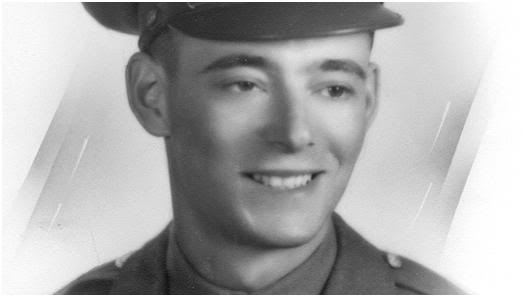
1940s photograph of Robert Ettinger, who served in the US Army in Belgium during World War II. Picture: Wikipedia Source: Supplied
THE man known as a father of the cryonics movement has died at 92 and his body is currently undergoing a five-day process to cool it for storage at a very low temperature.
The Detroit News reported Robert Ettinger, who died Saturday, will become the 106th patient at the organisation he founded, the Cryonics Institute, in Clinton Township, Michigan.
Once there, he will join his mother, who was the first cryo-preserved corpse at the institute in 1977, and his first and second wives, who were numbers two and 34 respectively.
The paper said Mr Ettinger did not want a memorial service because he believed he may return.
The five-day process to preserve Mr Ettinger’s body began within minutes of his death and involved packing the body on ice, using chemicals to limit freezer damage and slowly cooling it to the temperature of liquid nitrogen, the News reported.
Mr Ettinger’s son David told the paper his father’s body was expected to be ready to be submerged upside down in a liquid nitrogen filled tank by Thursday.
“He really has been viewed as the inspirational leader of the cryonics movement, and thousands of people around the world have looked up to him and will be upset that’s gone but hopeful that he will be back,” he said.
Read more at: http://www.heraldsun.com.au/technology/robert-ettinger-father-of-cryonics-joins-his-mother-and-two-wives-on-ice/story-fn7celvh-1226101952473
————————————
NEW YORK DAILY NEWS
Father of cryonics, Robert Ettinger, dead – for now?
BY DOAK JANTZEN
DAILY NEWS WRITER
Monday, July 25th 2011, 8:25 PM
Richard Lee/Detreoit Free Press /AP
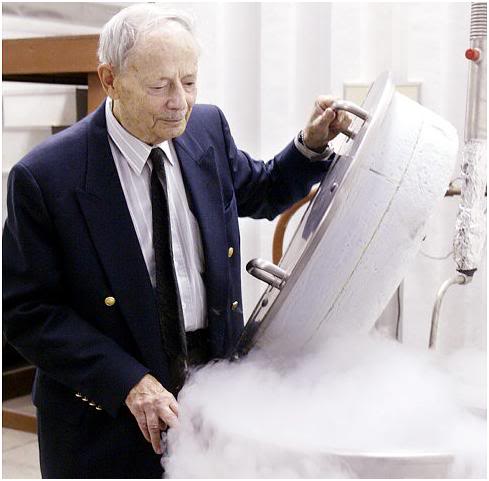 Robert Ettinger, former president of Cryonics Institute is shown at the institute facilities in Clinton Township, Mich., July 29, 2002.
Robert Ettinger, former president of Cryonics Institute is shown at the institute facilities in Clinton Township, Mich., July 29, 2002.
Robert Ettinger, a founder of the cryonics movement in the US, died — and began the process of cryopreservation — on Saturday, July 23, 2011.
With his blood replaced by antifreeze, Ettinger will spend the foreseeable future swimming in liquid nitrogen – at minus 320 degrees Fahrenheit.
He will be housed at the Cryonics Institute in Clinton Township, Michigan, which was founded in 1976 and is where Ettinger first froze his dead mother, followed by his first wife.
The founder will be the 106th patient to be frozen.
Ettinger was born in Atlantic City in 1918. In the 1920s his family moved to Detroit and he began reading science-fiction in Hugo Gernsback’s “Amazing Stories” magazines.
According to a New Yorker profile, it was Neil R. Jones’ story “The Jameson Satellite,” published in the magazine in 1931, which first sparked his interest in immortality.
In 1964 he published his cryonics manifesto, “The Prospect of Immortality,” which envisioned a world in which no one ever dies, overcrowding is handled by sharing the earth in shifts, and science, perfected over the ages, can cure all human ailments.
The process of cryonics aims to render the patient immortal by keeping their body around long enough for the science of reanimation to catch up. According to the Institute’s website, liquid nitrogen cools the body “to a temperature where physical decay essentially stops,” so that, while dead, one’s body does not rot.
Over 900 people worldwide have signed up as members of Ettinger’s Cryonics Institute alone. Besides the 106 frozen patients, the wearhouse holds 179 human tissue/DNA samples, 51 pet tissue/DNA samples, and 78 pets in cryostasis according to its website.
Most famously, Boston Red Sox left fielder Ted Williams’ head was cryonically frozen after his death in 2002, though not at the Cryonics Institute, but at the Alcor Life Extension Foundation in Arizona, a rival company founded in 1972 by Fred and Linda Chamberlain.
Read more at: http://www.nydailynews.com/tech_guide/2011/07/25/2011-07-25_father_of_cryonics_robert_ettinger_dead__for_now.html
————————————
WALL STREET JOURAL
Robert Ettinger | 1918-2011
Pursuing A Frozen Path
By STEPHEN MILLER
Robert Ettinger was the leading apostle of cryonics, the practice of freezing corpses in the hope that one day science will bring them back to life, cure what killed them and restore them to youth and vigor.
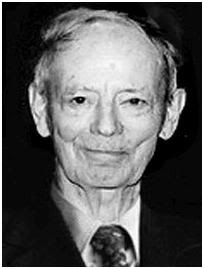 Robert Ettinger
Robert Ettinger
Mr. Ettinger, who died Saturday at age 92, popularized cryonics in his 1962 book, “The Prospect of Immortality,” where he wrote, “Sooner or later our friends of the future should be equal to the task of reviving and curing us.”
In 1976, Mr. Ettinger founded the Cryonics Institute in a Detroit suburb, where he eventually stored more than 100 bodies in giant vats of liquid nitrogen, at 320 degrees below zero. Clients must be declared legally dead prior to immersion.
The price for preservation at the institute is about $30,000, including perpetual care. Mr. Ettinger is now preserved there.
“Our patients are not truly dead in any fundamental sense,” he told the New Yorker in a 2010 profile. None have ever been brought back to life, and many scientists are skeptical about cryonics.
Mr. Ettinger’s enthusiasm for suspended animation proved infectious: At least a half-dozen other cryonic-suspension organizations exist in the U.S., Russia and Portugal, with hundreds of frozen clients awaiting revivification.
The son of Jewish immigrants who ran a furniture store in Detroit, Mr. Ettinger grew up reading science fiction and studied physics and mathematics in college. He went to teach physics at Wayne State University and Highland Park Community College, both in Michigan.
Mr. Ettinger fought in World War II and was badly injured by German mortar fire, which left him with a permanent limp. While recuperating in a hospital stateside, Mr. Ettinger began musing about mortality and in 1948 published “The Penultimate Trump,” a science-fiction story about a man who is frozen and revived centuries later.
Inspired in part by British advances in freezing and thawing living cells, Mr. Ettinger began producing nonfiction articles on the topic for magazines. He then wrote “The Prospect of Immortality,” which garnered newspaper articles and interviews on TV and radio. Cryonics societies sprang up in New York and California. In 1967 the first human was cryonically preserved, a California psychology professor, kicking off what Mr. Ettinger called “The Freezer Era.”
He rejected cloning as an alternative route to immortality, because “all it does it get you a twin.”
Mr. Ettinger went on to found the nonprofit Cryonics Institute where the first client to be preserved was his mother. He went on to preserve his wife after she died. He remarried and his second wife was also preserved upon death. But he failed to persuade his father or his brother to join the frozen members of his family.
“That was one of my major sorrows,” Mr. Ettinger said in 2010. “He was my brother. I had hoped to save him from death.”
Unlike other cryonic organizations, Mr. Ettinger’s Cryonics Institute freezes only entire bodies, not just heads as some organizations do, at reduced cost. This practice—neurocryopreservation—became notorious when it was revealed that baseball slugger Ted Williams had undergone the procedure after death.
Write to Stephen Miller at stephen.miller@wsj.com
Read more at: http://online.wsj.com/article/SB10001424053111904772304576468460105071604.html
————————————
ABC NET.COM
US cryonics founder dies, has body frozen
Posted July 26, 2011 06:54:24
Robert Ettinger, the founder of a movement that advocates storing bodies at ultra-low temperatures after death until new technology allows them to be revived, has died and his body frozen at the institute he founded, his family said Monday.
Mr Ettinger died on Saturday at his home in Clinton Township, Michigan and “has been frozen at the Institute,” a statement sent to AFP by his son David said.
The Cryonics Institute, which Mr Ettinger founded in 1976 as a “non-profit organisation that could freeze and store patients at death” has more than 900 members around the world and “106 patients in storage,” the statement says.
Born in 1918, Mr Ettinger went public with his theory of cryonics in 1964 with the publication of his work The Prospect of Immortality.
In the book, he contends that “at very low temperatures it is possible, right now, to preserve dead people with essentially no deterioration, indefinitely.
“If civilisation endures, medical science should eventually be able to repair almost any damage to the human body, including freezing damage and senile debility or other cause of death,” he said in the book.
“No matter what kills us, whether old age or disease, and even if freezing techniques are still crude when we die, sooner or later our friends of the future should be equal to the task of reviving and curing us.”
Mr Ettinger’s keen interest in the life-saving promise held by future medical technology was sparked, according to the statement, by the years he spent in hospitals after he was seriously wounded in combat in World War II.
“His legs were saved as a result of then innovative bone graft surgery. That sparked Mr Ettinger’s interest in the promise of future medical technology,” the statement says.
AFP
Topics: human-interest, death, united-states
Read more at: http://www.abc.net.au/news/2011-07-26/cryonics-founder-dies/2810076
————————————
SYDNEY HERALD SUN
Father of cryonics Robert Ettinger dies, body starts freezing process
• From: NewsCore
• July 26, 2011 6:38AM
THE man known as a father of the cryonics movement has died at 92 and his body is currently undergoing a five-day process to cool it for storage at a very low temperature.
The Detroit News reported Robert Ettinger, who died Saturday, will become the 106th patient at the organisation he founded, the Cryonics Institute, in Clinton Township, Michigan.
Once there, he will join his mother, who was the first cryo-preserved corpse at the institute in 1977, and his first and second wives, who were numbers two and 34 respectively.
The paper said Mr Ettinger did not want a memorial service because he believed he may return.
The five-day process to preserve Mr Ettinger’s body began within minutes of his death and involved packing the body on ice, using chemicals to limit freezer damage and slowly cooling it to the temperature of liquid nitrogen, the News reported.
Start of sidebar. Skip to end of sidebar.
Related Coverage
• Cryogenics advocate dies, body frozen Herald Sun, 17 hours ago
• I have seen the future The Australian, 8 Jul 2011
• Death-defying bids to stave off inevitable The Australian, 29 Apr 2011
• Deep freeze as an injury aid Adelaide Now, 7 Apr 2011
• Man dies as thieves target hair extensions Herald Sun, 19 Mar 2011
End of sidebar. Return to start of sidebar.
It quoted his son, David, as saying the body was expected to be ready to be submerged upside down in a liquid nitrogen filled tank by Thursday.
“He really has been viewed as the inspirational leader of the cryonics movement, and thousands of people around the world have looked up to him and will be upset that’s gone but hopeful that he will be back,” David Ettinger said.
Read more at: http://www.heraldsun.com.au/news/breaking-news/father-of-cryonics-robert-ettinger-dies-body-starts-freezing-process/story-e6frf7jx-1226101738208
————————————
THE AUSTRALIAN AGE
An idea frozen in time that promises life hereafter
July 26, 2011
CA Residents Save $400, Exp 8/22. In support of CA cord blood policy
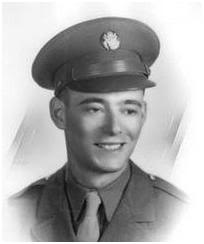 Robert Chester Wilson Ettinger.
Robert Chester Wilson Ettinger.
ROBERT CHESTER WILSON ETTINGER IMMORTALIST 4-12-1918 – 23-7-2011
ROBERT Ettinger, the intellectual father of the cryonics movement, whose members have themselves frozen at death pending scientific resurrection, has died at his home at Clinton Township in, Michigan, in the United States. He was 92.
Ettinger styled himself an ”immortalist”, since he argued that whole body or head-only freezing (”neurological suspension”) was only one means of achieving indefinite life. His rationale for pursuing this goal was contained in his book The Prospect Of Immortality (1964), which revealed him as an unquenchable optimist about mankind’s technological future.
Robert Chester Wilson Ettinger.
A physics teacher with an interest in science fiction, he predicted the evolution of machines that would manufacture from raw atoms all that humans needed. He foresaw intergalactic settlement, and argued that science would produce medical machines that would cure all diseases.
What now seemed to be a fatal illness would be no more than a twinge by 2050. From this it followed that the dead might be ”cured” by the doctors of the future.
Introducing what he called the Freezer Era, Ettinger described a world in which people would become nobler and more responsible as they were confronted with the reality of living forever. And if Earth became too crowded with long-lived humans? ”The people could simply agree to share the available space in shifts,” he wrote, ”going into suspended animation from time to time to make room for others”.
Ettinger proposed that governments immediately initiate a mass-freezing program. He suggested that this might have huge social benefits. To pay the premiums on their frozen families, people would need steady work and would be compelled to live responsible lives. He predicted that when immortality was achieved, crime would become extinct, since criminals would be afraid of justice pursuing them beyond the grave. Immortality would secure for man a higher, nobler nature.
The authorities remained unmoved. But his book proved popular and did inspire a number of cryonics organisations. In 1967, the first man was drained of blood and permeated with cryoprotectant (a sort of human antifreeze) and placed in a vat of liquid nitrogen at minus 196 degrees.
Despite Ettinger’s lofty aims, there were also opportunists, who imagined that cryonics would become big business, and outright ghouls. In the 1970s, one Californian cryonics society went bust without informing the relatives of its dozen ”patients”, who found their loved ones decomposing in packing cases in a suburban crypt. The head of that business had found alternative work repairing television sets.
The movement is hated by orthodox scientists, who hold that resurrecting a frozen body would be like ”trying to turn a hamburger back into a cow”.
The Cryonics Institute in the United States claims there are about 900 dues-paying members around the world (payments range between $US28,000 and $US150,000) who plan to be frozen when their time comes. The Cryonics Association of Australia says at least eight Australians have been frozen at death and the association has 25 affiliates, with a number of others also signed up.
The son of Russian immigrants of Jewish stock, Ettinger was born in Atlantic City, New Jersey, and went to school in Detroit after his family moved there, and then on to Wayne State University, where he studied physics and maths. He grew up a determined atheist.
During World War II he served as a second lieutenant (pictured, left) and was wounded before the Battle of the Bulge. The scenes of destruction he witnessed during the war had little effect on his immortalist views.
After the war he taught physics at Wayne State University and at a college near Michigan. He had begun brooding on the possibilities of cryonics in the 1930s, and was later inspired by The Jameson Satellite, a science-fiction short story by Neil Jones, about a man who has his corpse placed into orbit in the belief that the cold of outer space would preserve him. Millions of years passed, and the human race died out. Then a race of advanced aliens came along with mechanical bodies; they took the man’s frozen brain, and put it in a mechanical body.
”It was immediately obvious to me,” Ettinger said, ”that the author had missed the main point of his own story – namely that if there was any sense at all in expecting a frozen person to be revived someday, there was no point in waiting for aliens to do it in millions of years. We could do it ourselves in a very short time, and not just for a few eccentrics, but for everybody.
”We have to wait for the technology of revival. But we have to see to the arrangements of freezing ourselves, because most of us are going to die long before the technology is there.”
In 1947, Ettinger wrote a short story on the theme, fully expecting that other more influential people would pick up on his idea. When, by 1960, no mass freezing program had been initiated, Ettinger wrote an essay on the subject, dealing mainly with ”the insurance aspect”, which he sent to about 200 people selected at random from Who’s Who In America.
There was ”virtually zero response”, so he wrote The Prospect of Immortality, which was first published privately. The sequel, Man Into Superman, appeared in 1968.
Ettinger retired from teaching in 1972, but to the end remained convinced that cryonics would catch on. ”Someday there will be some sort of psychological trigger that will move all these people to take the practical steps they have not yet taken. When people realise that their children and grandchildren will enjoy indefinite life,” he said, ”that they may well be the last generation to die.”
He took encouragement from advances in nano-technology, the manipulation of computers at a microscopic level, which he thought would provide the machinery to successfully repair frozen corpses.
Ettinger’s frozen body has joined those of his mother and two wives in cold storage. His first patient was his mother, Rhea, who died in 1977. ”I don’t know if she was very enthusiastic about it,” he said, ”but she was willing.” A decade later, he froze his second patient – his wife Elaine, who died in 1987 and with whom he had two children. The next year he married his second wife, Mae. When she died in 2000, she was the institute’s 34th patient.
Cryonics was a serious topic for Ettinger, but he had a sense of humour. ”If both of my wives are revived,” he said last year, ”that will be a high class problem.”
He is survived by a son, David, and daughter, Shelley, from his first marriage, both of whom are active immortalists.
Read more: http://www.theage.com.au/national/obituaries/an-idea-frozen-in-time-that-promises-life-hereafter-20110725-1hx1f.html#ixzz1TFh7ox00
————————————
TELEGRAPH (LONDON, UK)
All Headline News
Father of Cryonics dies, has body frozen
Cost for cryo-freezing starts at $30,000.
Source: (AHN)
Reporter: Ayinde O. Chase
Location: Traverse City, MI, United States Published: July 26, 2011 03:18 pm EDT
Topics: Human Interest, Curiosity, Science And Technology, Technology, Human Interest, People
Robert Ettinger, founder of the cryonics movement in the United States has died and had his body placed in a tank of liquid nitrogen. It is his hope that someday in the future medical technology can bring him back to life.
Ettinger, who died Saturday, will become the 106th patient at the organisation he founded, the Cryonics Institute, in Clinton Township, Michigan.
He is now joined at the facility with his mother, who was the first cryo-preserved corpse at the there in 1977. He is also in the company of both his first and second wives, who were numbers two and 34 respectively.
“If civilization endures, medical science should eventually be able to repair almost any damage to the human body,” he wrote, “including freezing damage and senile debility or other cause of death.”
He also said, “No matter what kills us, whether old age or disease, and even if freezing techniques are still crude when we die, sooner or later our friends of the future should be equal to the task of reviving and curing us.”
The price for preservation at the institute is about $30,000, including ongoing perpetual care.
“My father devoted himself to doing what he could to enable his family, his friends and others to come back and live again,” said his son David. “Whether he will achieve that nobody knows at this point, but we think he has a good shot.”
One of Etttinger’s final wishes was that no memorial service be held because he believed he may return.
The 92-year-old pioneer died in his home in a suburb outside of Detroit after weeks of fighting declining health.
Read more: http://www.allheadlinenews.com/articles/90055380?Father%20of%20Cryonics%20dies%2C%20has%20body%20frozen#ixzz1TFhgvFBK
————————————
INTERNATIONAL BUSINESS TIMES
Life After Death: Cryonics Pioneer Robert Ettinger Dies
By IBTimes Staff Reporter | July 26, 2011 12:53 AM EDT
Robert Ettinger, the founding father of the cryonics movements that believes in the low-temperature preservation of the dead with the hope that healing and resuscitation may be possible in the future, died on Saturday. He was 92.
Ettinger died in his home in the Detroit suburb of Clinton Township. His health had been declining in recent weeks, his son David Ettinger said. Ettinger’s body became the 106th to be stored at the Cryonics Institute which he founded in 1976.
Etiinger, the son of Jewish immigrants, served in the U.S. military during World War II and was severely wounded in battle in Germany. While recuperating in hospitals, Ettinger nurtured the idea of preserving life through technology.
Ettinger who grew up on Science fiction was especially inspired by a Neil R. Jones story, “The Jameson Satellite, which he read when he was 12. The tale, about a man who has his corpse placed into orbit in the belief that the cold of outer space would preserve him and was discovered millions of years later by an advanced race of aliens who put the man’s brains in a mechanical body, got Ettinger brooding on the possibilities of cryonics in the 1930′s. It was Ettinger’s founding document on cryonics, “The Prospect of Immortality” that made him an overnight celebrity and garner a lot of media attention. Following the publication of the document, which describes the practical and moral aspects of deep-freezing the dead, Ettinger made a lot of television appearances with David Frost, Johnny Carson, Steve Allen, among others.
“If civilization endures, medical science should eventually be able to repair almost any damage to the human body,” he wrote, “including freezing damage and senile debility or other cause of death.”
He added: “No matter what kills us, whether old age or disease, and even if freezing techniques are still crude when we die, sooner or later our friends of the future should be equal to the task of reviving and curing us.”
“The Prospect of Immortality” led to various Cryonics societies springing up in New York and California. In 1966 Ettinger was elected the President of the Cryonics Society of Michigan which was later transformed under his direction into the Cryonics Institute in 1976. More than 100 bodies are stored at the institute in giant vats of liquid nitrogen, at 320 degrees below zero. The price for preservation at the institute is about $30,000, including perpetual care. Ettinger’s mother became the first to be preserved there. He went on to preserve his first and second wife at the Institute. The Cryonics Institute has 900 members. Similar facilities for preserving dead bodies operate in Arizona, California and Russia.
Ettinger who taught physics at Wayne State University strongly believed that someday medical science and technology would become advanced and sophisticated enough to heal the preserved bodies and bring them back to life.
“He did what he thought was necessary and appropriate and didn’t worry much about what people thought. The people who are scoffers are like the people who said heavier-than-air flight won’t work,” David Ettinger told the Associated Press.
Read more at: http://www.ibtimes.com/articles/186694/20110726/robert-ettinger-cryonics-immortality.htm
————————————
WIRED.CO.UK
Founder of the cryonics movement dies (and is frozen)
By Katie Scott
26 July 11
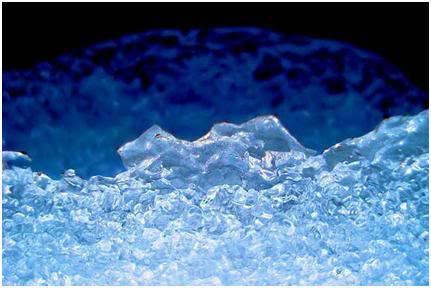
Robert Ettinger — the founder of the cryonics movement –has died aged 92, and his body has now been frozen.
Ettinger died at his home in Michigan and his body has now beencryopreserved at the Cryonics Institute. Among the 105 people already stored at the facility are his mother Rhea, and his two wives: Elaine, and former editor of The Immortalist magazine, Mae. The Wall Street Journal adds that Ettinger’s father and brother refused to be frozen.
Born in 1918, Ettinger was a university physics lecturer whose interest in medical engineering came about after sustaining a serious injury in the Second World War. He had to have bone graft surgery — which, at the time, was a nascent technique — and, says the Cryonics Institute, “sparked his interest in the promise of future medical technology.”
In 1964, Ettinger penned The Prospect of Immortality — a book “advocating and explaining the cryonics thesis”. In it he wrote: “If civilisation endures, medical science should eventually be able to repair almost any damage to the human body, including freezing damage and senile debility or other cause of death…Hence we need only arrange to have our bodies, after we die, stored in suitable freezers against the time when science may be able to help us.
“No matter what kills us, whether old age or disease, and even if freezing techniques are still crude when we die, sooner or later our friends of the future should be equal to the task of reviving and curing us.”
12 years later, in 1976, Ettinger founded the Cryonics Institute– a non-profit organisation, which freezes and then stores patients in liquid nitrogen at 320 degrees below zero — a process that costs around $28,000. The Institute has more than 900 members worldwide. Ettinger also founded the Immortalist Society and wrote other titles including Man into Superman.
His son, David Ettinger told the Guardian: “He did what he thought was necessary and appropriate and didn’t worry much about what people thought. The people who are scoffers are like the people who said heavier-than-air flight won’t work.”
————————————
+ MASS DEVICE
Founder of cryonics movement dies, is cryogenically frozen
July 26, 2011 by MassDevice staff
Robert Ettinger, founder of the Cryonics Institute, is stored in a freezer after death in hopes of being revived one day.
MASSDEVICE ON CALL — Cryonics Institute founder Robert Ettinger was stored in a freezer alongside his mother and first and second wives after passing away over the weekend in hopes of being revived in the future.
Ettinger is considered by some to be the father of the cryonics movement, through which sick or dying humans and animals who can’t be sustained by contemporary medicine are preserved at low temperatures under the assumption that science will one day unlock the key to reanimating the lifeless body and curing what ailed it.
“At very low temperatures it is possible, right now, to preserve dead people with essentially no deterioration, indefinitely,” Ettinger wrote in his 1962 novel, The Prospect of Immortality. “If civilization endures, medical science should eventually be able to repair almost any damage to the human body, including freezing damage and senile debility or other cause of death.”
Ettinger popularized the cryonics movement during the 1960s and 1970s by publishing novels and making the rounds at a television talk shows, including an appearance on The Tonight Show. He founded the Cryonics Institute in 1976, a non-profit organization that has over 900 members worldwide as well as 106 patients in storage, according to a press release.
Ettinger was 92 years old when he was frozen.
————————————
NEWSER
Cryonics Founder Robert Ettinger Dead … for Now
He’s frozen at 92
By Rob Quinn, Newser Staff
Posted Jul 26, 2011 2:39 AM CDT
DiggFarkLinkedInStumbleUponDeliciousGoogle BuzzRedditTumblr(Newser) – After a lifetime pushing the benefits of freezing dead people in the hope that they can someday be revived by medical science, Robert Ettinger has died—and been frozen. The 92-year-old father of the cryonics movement has joined 105 other people—including his mother and two wives—frozen in liquid nitrogen at the Cryonics Institute in Michigan he founded in 1976, AP reports.
Ettinger, a professor of physics, was seriously wounded in World War II and got the idea for preserving life through technology after receiving bone graft surgery to save his legs. “He did what he thought was necessary and appropriate and didn’t worry much about what people thought,” his son says, describing his father as a “reluctant prophet” who was unafraid of ridicule.
Read more at: http://www.newser.com/story/124302/father-of-cryonics-robert-ettinger-dead-at-92.html
————————————
UPI
U.S. News
Cryonics pioneer Ettinger dead at 92
Published: July 26, 2011 at 2:49 AM
LINTON TOWNSHIP, Mich., July 26 (UPI) — Robert Ettinger, who pioneered cryonics — the idea of freezing people’s bodies to be resurrected in the future, has died in Michigan at 92, his family said.
His son David told the Michigan news Web site MLive.com his father died Saturday at his home in Clinton Township. The Detroit News reported he died of respiratory failure.
Robert Ettinger was an early proponent of storing people’s bodies at very low temperature after death in hopes that future technology would allow for revival and curing of aging and disease.
Appropriately, upon his death he became the 106th person to go through the process at the organization he founded, the Cryonics Institute, the News said.
Over a period of five days, Ettinger’s body was being slowly cooled to the temperature of liquid nitrogen, and by Thursday is expected to be ready to be submerged upside down in a tank filled with liquid nitrogen, his son said.
“He really has been viewed as the inspirational leader of the cryonics movement, and thousands of people around the world have looked up to him and will be upset that’s [he's] gone but hopeful that he will be back,” David Ettinger said.
Robert Ettinger had said he was inspired in his effort by reading the science fiction story “The Jameson Satellite” when he was 14 years old, the News said.
David Ettinger said his father, a former Wayne State University physics professor, believed in taking facts and logic “and see where it leads you,” MLive.com said.
“Hopefully it leads us to see him again,” he said.
© 2011 United Press International, Inc. All Rights Reserved. Any reproduction, republication, redistribution and/or modification of any UPI content is expressly prohibited without UPI’s prior written consent.
Read more: http://www.upi.com/Top_News/US/2011/07/26/Cryonics-pioneer-Ettinger-dead-at-92/UPI-70501311662990/#ixzz1TFjrUP8T
————————————
WASHINGTON POST
Man Who Vowed to Live Forever Died Over the Weekend
Charlie Jane Anders
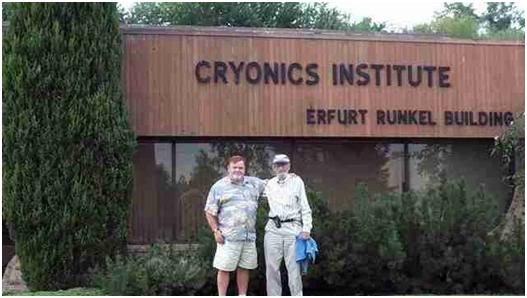 Robert C.W. Ettinger, who famously said that death was for the unprepared and the unimaginative, died on Saturday. But the physics teacher and science fiction writer may be coming back — his family froze his body cryogenically.
Robert C.W. Ettinger, who famously said that death was for the unprepared and the unimaginative, died on Saturday. But the physics teacher and science fiction writer may be coming back — his family froze his body cryogenically.
Ettinger, widely considered the founder of the cryogenics movement, is being stored in a vat of liquid nitrogen in a facility just outside Detroit, along with 100 other “immortalists” who were frozen at death. Ettinger wrote The Prospect of Immortality in 1962, arguing that people would become nobler and more responsible if they were going to live forever — and if the world got too crowded, everyone could take turns going into suspended animation. He told the New Yorker last year that his frozen clients are “not truly dead in any fundamental sense.”
Among those 100 people already frozen are Ettinger’s two deceased wives, one of whom died in 1987 and the other of whom died in 2000. If both women are revived at once, along with Ettinger himself, “that will be a high-class problem,” Ettinger once admitted. [Washington Post]
Photo via Cryonics.org.
————————————
THE DETROIT NEWS
Last Updated: July 25. 2011 6:07PM
Ettinger, father of cryonics movement, dies; placed in deep freeze
Kim Kozlowski/ The Detroit News
One of the founders of a movement to store people’s bodies at very low temperature after death in hopes that future technology would allow for revival and curing of aging and disease has died of respiratory failure. He was 92.
Robert Ettinger — the Clinton Township man widely regarded as the father of the cryonics movement — has become the 106th patient at the organization he founded, the Cryonics Institute, housed in a nondescript industrial park off Interstate 94 in Clinton Township.
The five-day process — which involved packing Ettinger’s body on ice, profusing with chemicals to limit freezer damage and slowly cooling to the temperature of liquid nitrogen — began within minutes of his death on Saturday afternoon to assure the least amount of damage. He is expected to be ready to be submerged upside down in a tank, known as a cryostat, filled with liquid nitrogen by Thursday, according to his son, David Ettinger.
“He really has been viewed as the inspirational leader of the cryonics movement, and thousands of people around the world have looked up to him and will be upset that’s gone but hopeful that he will be back,” said Ettinger, who was with his father when he died over the weekend.
Robert Ettinger was 14 years old when he read a science fiction story that spawned the idea that today is known as cryonics.
The story, “The Jameson Satellite,” relayed how a professor sent a corpse into the earth’s orbit for indefinite preservation. Millions of years later, aliens found the body, took the brain out and put it in a mechanical body. Ettinger thought the author missed the point of his own story.
“Why wait for aliens?” Ettinger told The Detroit News in 2009. “Why not do it ourselves?”
Ettinger served in World War II, where he was injured in Germany. He spent months in the hospital and discovered science was accelerating the concept of cryonics. He wrote to scores of people in Who’s Who of America, trying to persuade them to get behind the concept and do something about it.
When he got no response, he self-published a book in 1962 called “The Prospect of Immortality.” Two years later, Doubleday published the book, which was eventually translated into several languages, including French, German, Dutch and Italian.
“I thought the premise was so logical,” said Ettinger, who taught physics and math at Wayne State University and Highland Park Community College.
Ettinger founded the Cryonics Institute in 1976, first located in Detroit. He also founded the Immortalist Society, an organization devoted to education and research relating to cryonics and life extension.
He eventually relocated the institute to Clinton Township.
For years, membership was in the single digits, but it has exploded 500 percent since 2000 to more than 900 people from around the globe. All want either to preserve themselves, DNA or pets. The facility has preserved more than 64 animals, mostly dogs and cats, but a few birds and a hamster.
Besides his son, Ettinger leaves behind a daughter, Shelley Ettinger, who is not a member of the Cryonics Institute.
At the institute, Ettinger joins his mother, Rhea Ettinger, who was the first cryopreserved corpse at the institute, in 1977. He also joins his first and second wives, Elaine and Mae Ettinger, who were the institute’s No. 2 and 34 patients, respectively.
Ettinger didn’t want a memorial service because he believed he may come back again. But his son said there was discussion about having one during the annual meeting of the Cryonics Institute in September.
Memorials may be made to the institute or the Immortalist Society Research Fund.
kkozlowski@detnews.com
(313) 222-2024
From The Detroit News: http://detnews.com/article/20110725/METRO/107250393/Ettinger–father-of-cryonics-movement–dies–placed-in-deep-freeze#ixzz1TFkooMUE
————————————
MLIVE
Cryonics founder Robert Ettinger dies at 92, but family hopes to see him alive again in future
Published: Monday, July 25, 2011, 11:41 AM Updated: Monday, July 25, 2011, 1:36 PM
By Jonathan Oosting | MLive.com
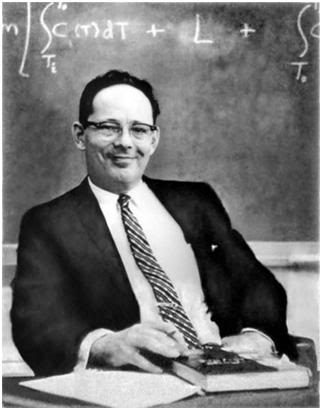 Courtesy Photo Robert Ettinger
Courtesy Photo Robert Ettinger
Robert Ettinger, the “father of cryonics,” died at his Clinton Township home on Saturday at the age of 92, but the movement he helped create gives his family hope they will see him again.
“My father didn’t believe in deferring to authority,” David Ettinger told MLive.com this morning. “He always said you take the facts, you take the logic and you see where it leads you. Hopefully it leads us to see him again.”
The former Wayne State University physics professor died of natural causes following weeks of poor health. His body was suspended in liquid nitrogen at the nonprofit Cryonics Institute, which he founded in 1976 after hypothesizing similar technology in his 1962 book The Prospect of Immortality.
He joins 105 other “frozen” patients at the Macomb County facility, including his wife and mother, which suspends bodies in an indefinite state of “cryostasis” as they await scientific breakthroughs that may allow them to be revived and rejuvenated.
David Ettinger described his father as a “reluctant prophet” who first began thinking about cryonics in the 1940s and — since no one else did — wrote a book and — since no one else did — opened the nonprofit in order to turn his idea into a “practical option.”
Robert Ettinger would go on to popularize the cryonics moment as a regular guest on The Tonight Show and through interviews with David Frost, Mike Douglas and Merv Griffin. He continued to publish books, and the Cryonics Institute saw a surge in popularity in recent years.
Asked about his father’s legacy, David Ettinger said it could be decades before his life’s work might reward him with additional life.
“I never had a conversation about how he would be remembered,” David Ettinger said. ” Memorial services and funerals didn’t interest him. He was interested in pracitically preserving his life.”
Related topics: Buzz, Cryonics Institute, Robert Ettinger
Read more at: http://www.mlive.com/news/detroit/index.ssf/2011/07/cryonics_founder_robert_etting.html
————————————
PR NEWSWIRE
Founder of Cryonics Movement Dies, is Frozen at Cryonics Institute
CLINTON TOWNSHIP, Mich., July 25, 2011 /PRNewswire/ — Robert Ettinger, the founder of the cryonics movement and of the Cryonics Institute, died on Saturday, July 23, at home in Clinton Township, Michigan, and has been frozen at the Institute. The cryonics movement advocates storage at very low temperatures after death in the hope that future technology will permit revival and the cure of aging and disease.
Mr. Ettinger wrote The Prospect of Immortality in 1962, a book advocating and explaining the cryonics thesis. From The Prospect of Immortality:
The fact: At very low temperatures it is possible, right now, to preserve dead people with essentially no deterioration, indefinitely…
The assumption: If civilization endures, medical science should eventually be able to repair almost any damage to the human body, including freezing damage and senile debility or other cause of death. . .
Hence we need only arrange to have our bodies, after we die, stored in suitable freezers against the time when science may be able to help us. No matter what kills us, whether old age or disease, and even if freezing techniques are still crude when we die, sooner or later our friends of the future should be equal to the task of reviving and curing us.
The Prospect of Immortality has been published around the world, with new editions currently in print or planned in South Korea, Taiwan and China.
Mr. Ettinger popularized the cryonics movement in the 1960s and 1970s through appearances on a wide variety of talk shows, including The Tonight Show and the David Frost, Mike Douglas and Merv Griffin programs.
Other books by Mr. Ettinger further discussed the cryonics thesis and the promise of future technology. They include Man Into Superman (1970) and Youniverse (2009). New Asian editions of Man into Superman are also currently planned. The Philosophy of Robert Ettinger (2002) is a collection of academic essays discussing Mr. Ettinger’s ideas.
Mr. Ettinger was born in 1918, and served in the U.S. Army in Belgium during World War II, where he was seriously wounded. Mr. Ettinger spent several years in hospitals after the war, and his legs were saved as a result of then innovative bone graft surgery. That sparked Mr. Ettinger’s interest in the promise of future medical technology.
Mr. Ettinger founded the Cryonics Institute in 1976 in order to create a non-profit organization that could freeze and store patients at death. CI (www.cryonics.org) has over 900 members worldwide in addition to 106 patients in storage. As advances in research have further confirmed the likelihood of dramatic improvements in future medicine, the cryonics movement has grown to include thousands of supporters worldwide, including organizations in Russia, Australia, Germany and other locations.
Mr. Ettinger also founded the Immortalist Society, an organization devoted to education and research relating to cryonics and life extension.
SOURCE Cryonics Institute
————————————
SYDNEY MORNING HERALD
Cryonics founder dies and has his body frozen … at 92
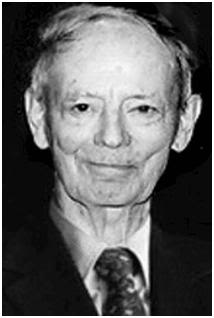
Robert Ettinger … founder of the Cryonics Institute.
Robert Ettinger, founder of a movement that advocates storing bodies at ultra-low temperatures after death until new technology allows them to be revived, has died and his body has been frozen at the institute he founded.
Mr Ettinger died aged 92 at his home in Clinton Township, Michigan, in the US on Saturday.
His body “has been frozen at the institute”, his son David said in a statement.
Advertisement: Story continues below
The Cryonics Institute, which Mr Ettinger founded in 1976 as a “non-profit organisation that could freeze and store patients at death” has more than 900 members around the world and “106 patients in storage”, the statement said.
Born in 1918, Mr Ettinger went public with his theory of cryonics in 1964 with the publication of his work, The Prospect of Immortality.
In the book, he contends that “at very low temperatures it is possible, right now, to preserve dead people with essentially no deterioration, indefinitely”.
“If civilisation endures, medical science should eventually be able to repair almost any damage to the human body, including freezing damage and senile debility or other cause of death,” he said in the book.
“No matter what kills us, whether old age or disease, and even if freezing techniques are still crude when we die, sooner or later our friends of the future should be equal to the task of reviving and curing us.”
Mr Ettinger’s keen interest in the life-saving promise held by future medical technology was sparked, according to the statement, by the years he spent in hospitals after he was seriously wounded in combat in World War II.
“His legs were saved as a result of then innovative bone graft surgery. That sparked Mr Ettinger’s interest in the promise of future medical technology,” the statement says.
New editions of The Prospect of Immortality are in print or in the planning stage in South Korea, Taiwan and China.
AFP
Read more: http://www.smh.com.au/technology/sci-tech/cryonics-founder-dies-and-has-his-body-frozen–at-92-20110726-1hxob.html#ixzz1TFm1Uyg8
————————————
BELFAST TELEGRAPH
Cryonics pioneer frozen after death
Tuesday, 26 July 2011
 Robert Ettinger, pioneer of the cryonics movement that advocates freezing the dead in the hope medical technology will enable them to live again some day, has died. He was 92.
Robert Ettinger, pioneer of the cryonics movement that advocates freezing the dead in the hope medical technology will enable them to live again some day, has died. He was 92.
The Cryonics Institute in the Detroit suburb of Clinton Township said Mr Ettinger died on Saturday and was promptly frozen.
Son David Ettinger said his father’s health was failing for some time.
Mr Ettinger senior first proposed storing dead bodies at low temperatures to await future revival in a 1964 book. He continued promoting the idea for decades in writing and public appearances.
He founded the Cryonics Institute in 1976. He is the 106th person whose body is stored at the institute at minus 321F (minus 196C) in liquid nitrogen.
David Ettinger said his father was a “reluctant prophet” who was not bothered by people ridiculing his ideas.
Read more: http://www.belfasttelegraph.co.uk/news/world-news/cryonics-pioneer-frozen-after-death-16027918.html#ixzz1TFmdekHM
————————————
ASSOCIATED PRESS
Cryonics Pioneer Robert Ettinger Dies, Body Frozen
Published July 26, 2011
| Associated Press
, pioneer of the cryonics movement that advocates freezing the dead in the hope that medical technology will enable them to live again someday, has died. He was 92.
Ettinger died Saturday at home in the Detroit suburb of Clinton Township after weeks of declining health, son David Ettinger said. His body became the 106th to be stored in at the Cryonics Institute, which he founded in 1976.
“My father devoted himself to doing what he could to enable his family, his friends and others to come back and live again,” David Ettinger told The Associated Press. “Whether he will achieve that nobody knows at this point, but we think he has a good shot.”
Robert Ettinger, who taught physics at Wayne State University, was seriously wounded during the Battle of the Bulge in World War II and spent years in hospitals. The bone graft surgery that spared his legs inspired his optimism about the future prospects of preserving life through technology, a Cryonics Institute statement said.
His son said Ettinger also was inspired by science fiction writings about deep-freezing the dead and expected researchers to make serious progress toward developing the idea. But when nothing seemed to be happening, he wrote a 1964 book, “The Prospect of Immortality,” introducing the concept of cryonics.
“If civilization endures, medical science should eventually be able to repair almost any damage to the human body,” he wrote, “including freezing damage and senile debility or other cause of death.”
He added: “No matter what kills us, whether old age or disease, and even if freezing techniques are still crude when we die, sooner or later our friends of the future should be equal to the task of reviving and curing us.”
Ettinger promoted his theory in other writings and appearances on television talk shows. The Cryonics Institute has 900 members. Similar facilities for preserving dead bodies operate in Arizona, California and Russia. Ettinger also established the Immortalist Society, a research and education group devoted to cryonics and extending the human life span.
The Cryonics Institute charges $28,000 to prepare a body and store it long-term in a tank of liquid nitrogen at minus-321 degrees Fahrenheit. The first person frozen there was Ettinger’s mother, Rhea Ettinger, who died in 1977. His two wives, Elaine and Mae, also are patients at the Institute.
Ettinger was never bothered by ridicule and was a “reluctant prophet,” his son said.
“He did what he thought was necessary and appropriate and didn’t worry much about what people thought,” David Ettinger said. “The people who are scoffers are like the people who said heavier-than-air flight won’t work.”
Read more: http://www.foxnews.com/health/2011/07/26/cryonics-pioneer-robert-ettinger-dies-body-frozen/#ixzz1TFnBoAfa
————————————
FORBES
Associated Press
Cryonics pioneer Robert Ettinger dies, body frozen
By JOHN FLESHER , 07.26.11, 08:34 AM EDT
TRAVERSE CITY, Mich. — Robert Ettinger, pioneer of the cryonics movement that advocates freezing the dead in the hope that medical technology will enable them to live again someday, has died. He was 92.
Ettinger died Saturday at home in the Detroit suburb of Clinton Township after weeks of declining health, son David Ettinger said. His body became the 106th to be stored in at the Cryonics Institute, which he founded in 1976.
“My father devoted himself to doing what he could to enable his family, his friends and others to come back and live again,” David Ettinger told The Associated Press. “Whether he will achieve that nobody knows at this point, but we think he has a good shot.”
Robert Ettinger, who taught physics at Wayne State University, was seriously wounded during the Battle of the Bulge in World War II and spent years in hospitals. The bone graft surgery that spared his legs inspired his optimism about the future prospects of preserving life through technology, a Cryonics Institute statement said.
His son said Ettinger also was inspired by science fiction writings about deep-freezing the dead and expected researchers to make serious progress toward developing the idea. But when nothing seemed to be happening, he wrote a 1964 book, “The Prospect of Immortality,” introducing the concept of cryonics.
“If civilization endures, medical science should eventually be able to repair almost any damage to the human body,” he wrote, “including freezing damage and senile debility or other cause of death.”
He added: “No matter what kills us, whether old age or disease, and even if freezing techniques are still crude when we die, sooner or later our friends of the future should be equal to the task of reviving and curing us.”
Ettinger promoted his theory in other writings and appearances on television talk shows. The Cryonics Institute has 900 members. Similar facilities for preserving dead bodies operate in Arizona, California and Russia. Ettinger also established the Immortalist Society, a research and education group devoted to cryonics and extending the human life span.
The Cryonics Institute charges $28,000 to prepare a body and store it long-term in a tank of liquid nitrogen at minus-321 degrees Fahrenheit. The first person frozen there was Ettinger’s mother, Rhea Ettinger, who died in 1977. His two wives, Elaine and Mae, also are patients at the Institute.
Ettinger was never bothered by ridicule and was a “reluctant prophet,” his son said.
“He did what he thought was necessary and appropriate and didn’t worry much about what people thought,” David Ettinger said. “The people who are scoffers are like the people who said heavier-than-air flight won’t work.”
Copyright 2011 The Associated Press. All rights reserved. This material may not be published, broadcast, rewritten or redistributed.
Read more at: http://www.forbes.com/feeds/ap/2011/07/25/general-us-obit-ettinger_8583693.html
————————————
NEW YORK NEWSDAY
Cryonics pioneer Robert Ettinger dies, body frozen
Originally published: July 25, 2011 7:04 PM
Updated: July 25, 2011 8:18 PM
By The Associated Press JOHN FLESHER (Associated Press)
Cryonics pioneer Robert Ettinger dies, body frozen at institute in hope of future resurrection
(AP) — Robert Ettinger, pioneer of the cryonics movement that advocates freezing the dead in the hope that medical technology will enable them to live again someday, has died. He was 92.
Ettinger died Saturday at home in the Detroit suburb of Clinton Township after weeks of declining health, son David Ettinger said. His body became the 106th to be stored in at the Cryonics Institute, which…
————————————
CBS MONEY WATCH
Cryonics pioneer Robert Ettinger dies, body frozen
BY ASSOCIATED PRESS | JUL 26, 2011 8:35 AM ET | 0 COMMENTS
TRAVERSE CITY, Mich. — Robert Ettinger, pioneer of the cryonics movement that advocates freezing the dead in the hope that medical technology will enable them to live again someday, has died. He was 92.
Ettinger died Saturday at home in the Detroit suburb of Clinton Township after weeks of declining health, son David Ettinger said. His body became the 106th to be stored in at the Cryonics Institute, which he founded in 1976.
“My father devoted himself to doing what he could to enable his family, his friends and others to come back and live again,” David Ettinger told The Associated Press. “Whether he will achieve that nobody knows at this point, but we think he has a good shot.”
Robert Ettinger, who taught physics at Wayne State University, was seriously wounded during the Battle of the Bulge in World War II and spent years in hospitals. The bone graft surgery that spared his legs inspired his optimism about the future prospects of preserving life through technology, a Cryonics Institute statement said.
His son said Ettinger also was inspired by science fiction writings about deep-freezing the dead and expected researchers to make serious progress toward developing the idea. But when nothing seemed to be happening, he wrote a 1964 book, “The Prospect of Immortality,” introducing the concept of cryonics.
“If civilization endures, medical science should eventually be able to repair almost any damage to the human body,” he wrote, “including freezing damage and senile debility or other cause of death.”
He added: “No matter what kills us, whether old age or disease, and even if freezing techniques are still crude when we die, sooner or later our friends of the future should be equal to the task of reviving and curing us.”
Ettinger promoted his theory in other writings and appearances on television talk shows. The Cryonics Institute has 900 members. Similar facilities for preserving dead bodies operate in Arizona, California and Russia. Ettinger also established the Immortalist Society, a research and education group devoted to cryonics and extending the human life span.
The Cryonics Institute charges $28,000 to prepare a body and store it long-term in a tank of liquid nitrogen at minus-321 degrees Fahrenheit. The first person frozen there was Ettinger’s mother, Rhea Ettinger, who died in 1977. His two wives, Elaine and Mae, also are patients at the Institute.
Ettinger was never bothered by ridicule and was a “reluctant prophet,” his son said.
“He did what he thought was necessary and appropriate and didn’t worry much about what people thought,” David Ettinger said. “The people who are scoffers are like the people who said heavier-than-air flight won’t work.”
Copyright 2011 The Associated Press. All rights reserved. This material may not be published, broadcast, rewritten or redistributed.
Read more: http://moneywatch.bnet.com/economic-news/news/cryonics-pioneer-robert-ettinger-dies-body-frozen/6265145/#ixzz1TFotOjDT
————————————
GANT DAILY.COM
Father of Cryonics dies, has body frozen
July 26, 2011 at 11:18 AM by AHN • Leave a Comment
Ayinde O. Chase – AHN News Staff
Traverse City, MI, United States (AHN) – Robert Ettinger, founder of the cryonics movement in the United States has died and had his body placed in a tank of liquid nitrogen. It is his hope that someday in the future medical technology can bring him back to life.
Ettinger, who died Saturday, will become the 106th patient at the organisation he founded, the Cryonics Institute, in Clinton Township, Michigan.
He is now joined at the facility with his mother, who was the first cryo-preserved corpse at the there in 1977. He is also in the company of both his first and second wives, who were numbers two and 34 respectively.
“If civilization endures, medical science should eventually be able to repair almost any damage to the human body,” he wrote, “including freezing damage and senile debility or other cause of death.”
He also said, “No matter what kills us, whether old age or disease, and even if freezing techniques are still crude when we die, sooner or later our friends of the future should be equal to the task of reviving and curing us.”
The price for preservation at the institute is about $30,000, including ongoing perpetual care.
“My father devoted himself to doing what he could to enable his family, his friends and others to come back and live again,” said his son David. “Whether he will achieve that nobody knows at this point, but we think he has a good shot.”
One of Etttinger’s final wishes was that no memorial service be held because he believed he may return.
The 92-year-old pioneer died in his home in a suburb outside of Detroit after weeks of fighting declining health.
Article © AHN – All Rights Reserved
————————————
TRUTHDIVE.COM
Cryonics pioneer Robert Ettinger dead
Post a Comment July 26, 2011 – 5:53 pm By News Desk | Permalink | Print This Article |
Detroit (US), July 26 (ANI): Robert Ettinger, a pioneer of the cryonics movement, has died at his home in Detroit. He was 92.
Ettinger, who died on Saturday, has had his body frozen and stored at the facility he founded in the hope that medical technology will enable him to live again one day.
Ettinger’s body is the 106th to be frozen and stored at the Cryonics Institute, which he founded in 1976, the Gaurdian reports.
“My father devoted himself to doing what he could to enable his family, his friends and others to come back and live again,” said his son David.
“Whether he will achieve that nobody knows at this point, but we think he has a good shot,” he added.
Ettinger, a university physics teacher, was seriously wounded during the second world war at the Battle of the Bulge and spent years in hospitals. The bone graft surgery that saved his legs inspired his optimism about the prospects of preserving life through technology, a statement from the institute said. .
His son said Ettinger was also inspired by science fiction writings about deep freezing the dead, and expected researchers to make serious progress toward developing the idea.
But when nothing seemed to be happening, he wrote a 1964 book, The Prospect of Immortality, introducing the concept of cryonics.
Ettinger promoted his theory in other writings and appearances on television.
There are now similar facilities for preserving bodies in Arizona, California and in Russia.
Ettinger also established the Immortalist Society, a research and education group devoted to cryonics and extending the human life span. (ANI)
Read more at: http://truthdive.com/2011/07/26/Cryonics-pioneer-Robert-Ettinger-dead.html
————————————
CRAINS DETROIT
Originally Published: July 25, 2011 12:55 PM Modified: July 25, 2011 3:50 PM
Founder of cryonics movement frozen and stored in Clinton Township institute he began
By Ellen Mitchell
Robert Ettinger, the founder of the cryonics movement and the Cryonics Institute, died respiratory failure July 23 at home in Clinton Township and has been frozen at the institute he founded.
He was 92.
The cryonics movement advocates storage of bodies at very low temperatures after death in the hope that future technology will permit revival and the cure of aging and disease.
Ettinger founded the Cryonics Institute in 1976 as a nonprofit that freezes and stores patients after death. CI, based in Clinton Township, has more than 900 members worldwide and 106 patients in storage.
Ettinger popularized the cryonics movement in the 1960s and 1970s and wrote “The Prospect of Immortality” in 1962, advocating and explaining the cryonics thesis.
“No matter what kills us, whether old age or disease, and even if freezing techniques are still crude when we die, sooner or later our friends of the future should be equal to the task of reviving and curing us,” Ettinger wrote in “The Prospect of Immortality.”
Read more at: http://www.crainsdetroit.com/article/20110725/FREE/110729933#
————————————
SIOUXS CITY JOURNAL
Cryonics pioneer Robert Ettinger dies, body frozen
ASSOCIATED PRESS | POSTED: MONDAY, JULY 25, 2011 7:18 PM
Robert Ettinger, pioneer of the cryonics movement that advocates freezing the dead in the hope that medical technology will enable them to live again someday, has died. He was 92.
Ettinger died Saturday at home in the Detroit suburb of Clinton Township after weeks of declining health, son David Ettinger said. His body became the 106th to be stored in at the Cryonics Institute, which he founded in 1976.
“My father devoted himself to doing what he could to enable his family, his friends and others to come back and live again,” David Ettinger told The Associated Press. “Whether he will achieve that nobody knows at this point, but we think he has a good shot.”
Robert Ettinger, who taught physics at Wayne State University, was seriously wounded during the Battle of the Bulge in World War II and spent years in hospitals. The bone graft surgery that spared his legs inspired his optimism about the future prospects of preserving life through technology, a Cryonics Institute statement said.
His son said Ettinger also was inspired by science fiction writings about deep-freezing the dead and expected researchers to make serious progress toward developing the idea. But when nothing seemed to be happening, he wrote a 1964 book, “The Prospect of Immortality,” introducing the concept of cryonics.
“If civilization endures, medical science should eventually be able to repair almost any damage to the human body,” he wrote, “including freezing damage and senile debility or other cause of death.”
He added: “No matter what kills us, whether old age or disease, and even if freezing techniques are still crude when we die, sooner or later our friends of the future should be equal to the task of reviving and curing us.”
Ettinger promoted his theory in other writings and appearances on television talk shows. The Cryonics Institute has 900 members. Similar facilities for preserving dead bodies operate in Arizona, California and Russia. Ettinger also established the Immortalist Society, a research and education group devoted to cryonics and extending the human life span.
The Cryonics Institute charges $28,000 to prepare a body and store it long-term in a tank of liquid nitrogen at minus-321 degrees Fahrenheit. The first person frozen there was Ettinger’s mother, Rhea Ettinger, who died in 1977. His two wives, Elaine and Mae, also are patients at the Institute.
Ettinger was never bothered by ridicule and was a “reluctant prophet,” his son said.
“He did what he thought was necessary and appropriate and didn’t worry much about what people thought,” David Ettinger said. “The people who are scoffers are like the people who said heavier-than-air flight won’t work.”
Copyright 2011 The Associated Press. All rights reserved. This material may not be published, broadcast, rewritten or redistributed.
Posted in National on Monday, July 25, 2011 7:18 pm Updated: 9:02 pm. |
Read more: http://www.siouxcityjournal.com/news/national/article_8645c6a4-7f3f-561e-b631-dc1cfc425966.html#ixzz1TFqTxY7V
THE COLUMBUS DISPATCH
Robert C.W. Ettinger | 1918-2011
Father of cryonics chilling in freezer after his death
Tuesday, July 26, 2011 03:07 AM
By Emma Brown
The Washington Post
Robert C. W. Ettinger, a physics teacher and science-fiction writer who believed death is only for the unprepared and unimaginative, died Saturday at his home in Clinton Township, Mich.
He was 92 and had been in declining health, said his son David, who could not specify a cause. “We’re obviously sad,” he said, but, “We were able to freeze him under optimum conditions, so he’s got another chance.”
Ettinger is widely considered the father of the cryonics movement, whose adherents believe they can achieve immortality through quick-freezing their bodies at death in anticipation of resurrection.
Ettinger’s frozen body is being stored in a vat of liquid nitrogen at a nondescript building outside Detroit, home to more than 100 fellow immortalists – including his mother and two wives – who are awaiting revival.
If all goes as Ettinger envisioned, he will remain in a period of icy stasis for however long it takes for doctors, armed with technology of the future, to defrost him and restore him to good health.
Ettinger was a little-known community-college professor in the mid-1960s when he wrote the founding document of cryonics, “The Prospect of Immortality.”
Introducing what he called the Freezer Era, Ettinger described a world in which people would become nobler and more responsible as they were confronted with the reality of living forever.
And if Earth became too crowded with long-lived humans? “The people could simply agree to share the available space in shifts,” he wrote, “going into suspended animation from time to time to make room for others.”
Originally self-published in 1962, the book was put out by Doubleday in 1964. It launched Ettinger as a celebrity.
Ettinger’s dogma was covered in The New York Times and Newsweek, and he was invited to appear on talk shows hosted by Johnny Carson and David Frost.
Ettinger’s book helped spur the development of a number of organizations devoted to deep-freezing the dead, one of which – the now-defunct Cryonics Society of California – successfully froze a person for the first time in 1967.
The next decade, Ettinger founded his nonprofit Cryonics Institute. Today, his institute houses 106 human patients and dozens of dogs, cats and at least one parrot.
About 900 dues-paying members throughout the world plan to be frozen when their time comes. Total fees at his institute start at about $28,000.
Robert Chester Wilson Ettinger was born Dec. 4, 1918, in Atlantic City, N.J. He was a boy when he moved to Detroit and read a short story that sparked his interest in immortality.
“The Jameson Satellite,” by Neil Jones, told of a dying professor who launched himself into space, where he was found eons later by aliens who brought him back to life by transplanting his brain into a mechanical body.
Ettinger’s first patient was his mother, Rhea, who died in 1977.
A decade later, he froze his second patient: his wife Elaine, who died in 1987 and with whom he had two surviving children, David and Shelley.
The next year he married his second wife, Mae. When she died in 2000, she became the institute’s 34th patient.
“If both of my wives are revived,” Ettinger told the Detroit News last year, “that will be a high-class problem.”
Read more at: http://www.dispatch.com/live/content/national_world/stories/2011/07/26/father-of-cryonics-chilling-in-freezer-after-his-death.html?sid=101
SOME LINKS TO STORIES NOT REPRODUCED HERE:
MIAMI HERALD: http://www.miamiherald.com/2011/07/25/2330666/cryonics-pioneer-robert-ettinger.html
BANGOR DAILY NEWS: http://bangordailynews.com/2011/07/25/news/nation/robert-ettinger-founder-of-the-cryonics-movement-dies-at-92/
TULSA WORLD: http://www.tulsaworld.com/news/article.aspx?subjectid=13&articleid=20110726_11_A11_Robert679564&rss_lnk=1
DELTASELF: http://www.deltaself.com/2011/07/robert-ettinger-founder-of-the-cryonics-movement-dies-at-92/
ANDHRANEWS INDIA: http://www.andhranews.net/Intl/2011/Cryonics-pioneer-Robert-Ettinger-dead-dead-12810.htm


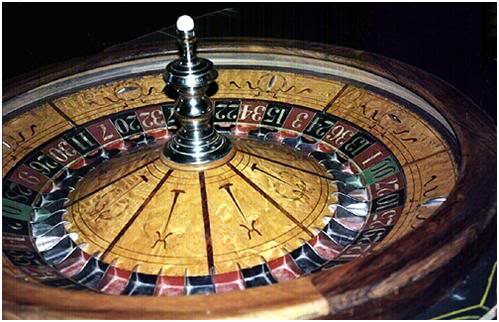
 Figure 2: The only way to beat the Devil is to outsmart him and out-bluff him – as well as have a little luck on your side.
Figure 2: The only way to beat the Devil is to outsmart him and out-bluff him – as well as have a little luck on your side. Figure 3: Not all games are created equal and not all gaming venues offer the same odds. Good judgment and skill actually allow a few people to make a very good living playing poker.
Figure 3: Not all games are created equal and not all gaming venues offer the same odds. Good judgment and skill actually allow a few people to make a very good living playing poker. Figure 4: The House Edge (HE), or vigorish, is the profit the casino makes by altering the odds in its favor. The HE varies from venue to venue and sometimes from time to time in the same venue. The HE is analogous to the “negatives” your cryonics organization brings to the table.
Figure 4: The House Edge (HE), or vigorish, is the profit the casino makes by altering the odds in its favor. The HE varies from venue to venue and sometimes from time to time in the same venue. The HE is analogous to the “negatives” your cryonics organization brings to the table.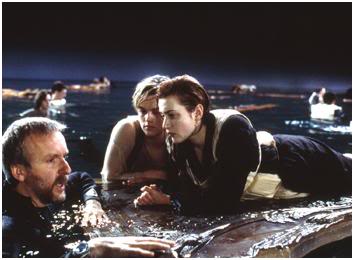 Figure 5: How many more would have survived if there had been 12, 24, or 48 hours to prepare instead of 2, before the Titanic sank? The odds of survival in a life or death situation are a result of the complex interplay between the time available, the physical resources, the human resources, the absence of panic and lastly, chance.
Figure 5: How many more would have survived if there had been 12, 24, or 48 hours to prepare instead of 2, before the Titanic sank? The odds of survival in a life or death situation are a result of the complex interplay between the time available, the physical resources, the human resources, the absence of panic and lastly, chance.  Figure 6: We are gambling for our lives; the stakes couldn’t be any higher. Do you want to win, or lose?
Figure 6: We are gambling for our lives; the stakes couldn’t be any higher. Do you want to win, or lose?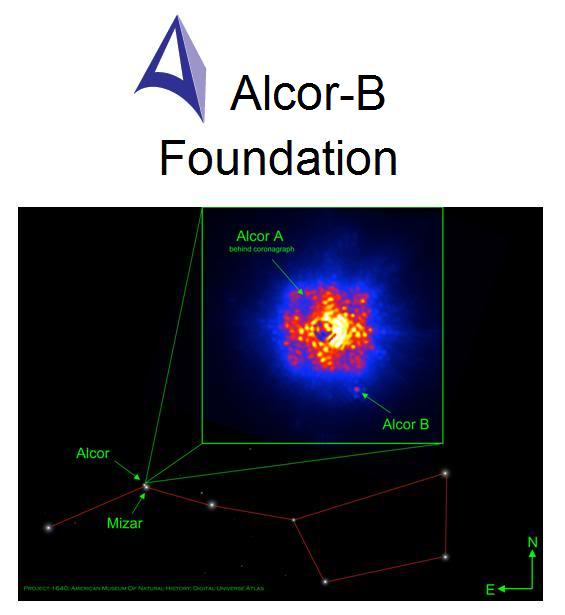 Figure 1: The Alcors are the second, smaller and dimmer companion stars to Mizar, the bright stars that comprise the crook in the handle of the Big Dipper constellation. In the Arab world of the 5th Century CE, Mizar’s much less bright (and more difficult to see) companion stars, Alcor-A and Alcor-B were used as tests for good vision. Only someone with the clearest and most acute visions could see the Alcor’s. Alcor-B was discovered early in 2011 using Project 1640m, which makes use of the Hale Telescope’s adaptive optics system. Project 1640 gives the Hale a view almost equal to what is possible in space. The instrument also has the ability to block out the light of a star, allowing faint objects located next to a star to be seen. The Hale, armed with Project 1640, was pointed at Alcor earlier this year and found that it isn’t a single star. Alcor has a small stellar companion that hadn’t been seen before: Alcor-B, a small, dim red dwarf star about one fourth the mass of our Sun. To see Alcor-B you must have the superior vision that only mastery of the most sophisticated technology allows. Alcor-B is thus a test for the clearest and most acute vision – vision capable of seeing things as they really are – not just as they appear to be.
Figure 1: The Alcors are the second, smaller and dimmer companion stars to Mizar, the bright stars that comprise the crook in the handle of the Big Dipper constellation. In the Arab world of the 5th Century CE, Mizar’s much less bright (and more difficult to see) companion stars, Alcor-A and Alcor-B were used as tests for good vision. Only someone with the clearest and most acute visions could see the Alcor’s. Alcor-B was discovered early in 2011 using Project 1640m, which makes use of the Hale Telescope’s adaptive optics system. Project 1640 gives the Hale a view almost equal to what is possible in space. The instrument also has the ability to block out the light of a star, allowing faint objects located next to a star to be seen. The Hale, armed with Project 1640, was pointed at Alcor earlier this year and found that it isn’t a single star. Alcor has a small stellar companion that hadn’t been seen before: Alcor-B, a small, dim red dwarf star about one fourth the mass of our Sun. To see Alcor-B you must have the superior vision that only mastery of the most sophisticated technology allows. Alcor-B is thus a test for the clearest and most acute vision – vision capable of seeing things as they really are – not just as they appear to be. Figure 2: Alcor-B President, Gorton Carpenter, M.D., Ph.D.
Figure 2: Alcor-B President, Gorton Carpenter, M.D., Ph.D. Figure 3: The primary existential risks that cryonics patients and Alcor-B staff face in the coming years. Arguably, two of those risks, climate change and economic upheaval are beginning to unfold at present.
Figure 3: The primary existential risks that cryonics patients and Alcor-B staff face in the coming years. Arguably, two of those risks, climate change and economic upheaval are beginning to unfold at present. Figure 4: The map above shows the probable extent of the spread of a highly infectious communicable disease in the US. By day 87 virtually all populated areas of any size are infected. The inset curve shows the rate of transmission from the start of the infection until saturation is reached at day ~ 87. There is a window of ~ 30-50 days where reverse quarantine measures may be effective, providing that the infection has not already entered our colony from contact with Phoenix, or other large metropolises.
Figure 4: The map above shows the probable extent of the spread of a highly infectious communicable disease in the US. By day 87 virtually all populated areas of any size are infected. The inset curve shows the rate of transmission from the start of the infection until saturation is reached at day ~ 87. There is a window of ~ 30-50 days where reverse quarantine measures may be effective, providing that the infection has not already entered our colony from contact with Phoenix, or other large metropolises.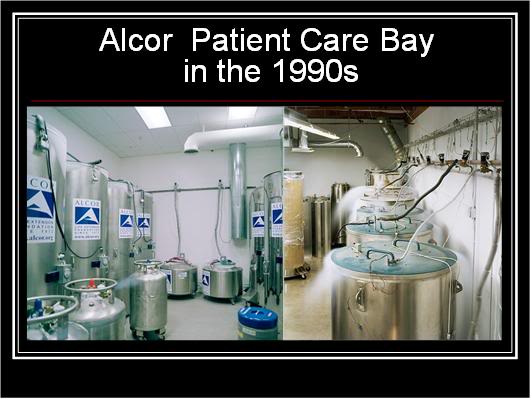 Figure 5: Two views of the Alcor-B Patient Care Bay during the interval from the mid-1990s (left) to the early 2000s (right).
Figure 5: Two views of the Alcor-B Patient Care Bay during the interval from the mid-1990s (left) to the early 2000s (right). Figure 6: The Alcor-B Patient Care Bay in 2009, shortly before the move to the Mobile, AZ Facility. (Photo by Murray Ballard.)
Figure 6: The Alcor-B Patient Care Bay in 2009, shortly before the move to the Mobile, AZ Facility. (Photo by Murray Ballard.) Figure 7: A contemporary view of the patient care area of the Cryonics Institute’s facility in Clinton Township, MI
Figure 7: A contemporary view of the patient care area of the Cryonics Institute’s facility in Clinton Township, MI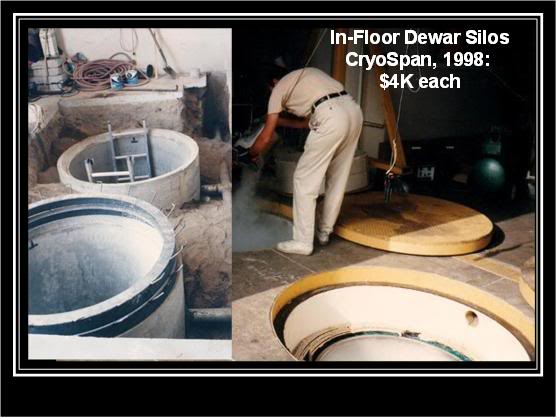 Figure 8: At left above, two of the below ground silos that housed Bigfoot dewars at the facilities of CryoSpan, Inc., in Rancho Cucamonga. CryoSpan is no longer in operation.
Figure 8: At left above, two of the below ground silos that housed Bigfoot dewars at the facilities of CryoSpan, Inc., in Rancho Cucamonga. CryoSpan is no longer in operation.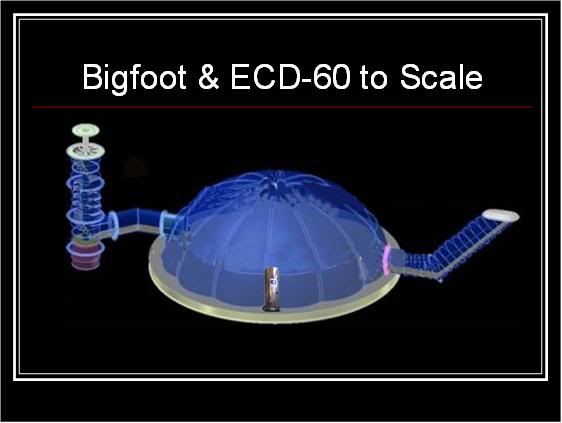 Figure 9: The relative scales of a standard, immersion LN2 storage Bigfoot dewar, and the ECD-60 dome that now houses Alcor-B’s patients.
Figure 9: The relative scales of a standard, immersion LN2 storage Bigfoot dewar, and the ECD-60 dome that now houses Alcor-B’s patients. Figure 10: The subterranean complex that comprises the maximally hardened parts of the Alcor-B Mobile, AZ Facility. The ECD-60 Dome serves as the hub from which 11 modules radiate like spokes. There are 6 residential modules, a hospital/dental module, a laboratory module which houses an emergency cryopreservation capability, a diesel fuel storage tank, a diesel powered electricity generating plant and a greenhouse which is used for storage of supplies until the facility becomes active in an emergency. The Patient Care Area is the in part of the ECD-60 that adjoins the clinical and technical spokes of the facility. The remainder of the ECD-60 houses the communications and defense center and is used for storage, communal dining and meeting spaces.
Figure 10: The subterranean complex that comprises the maximally hardened parts of the Alcor-B Mobile, AZ Facility. The ECD-60 Dome serves as the hub from which 11 modules radiate like spokes. There are 6 residential modules, a hospital/dental module, a laboratory module which houses an emergency cryopreservation capability, a diesel fuel storage tank, a diesel powered electricity generating plant and a greenhouse which is used for storage of supplies until the facility becomes active in an emergency. The Patient Care Area is the in part of the ECD-60 that adjoins the clinical and technical spokes of the facility. The remainder of the ECD-60 houses the communications and defense center and is used for storage, communal dining and meeting spaces.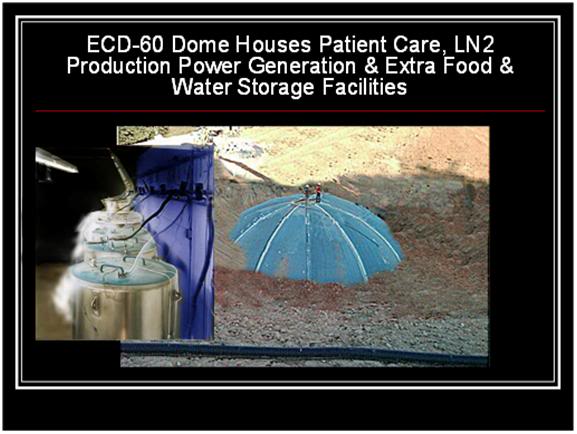 Figure 11: At right above, two men from the construction crew stand atop the ECD-60 shortly before the earth backfill was completed. At left above is the Patient Care Area of the facility as it appears today.
Figure 11: At right above, two men from the construction crew stand atop the ECD-60 shortly before the earth backfill was completed. At left above is the Patient Care Area of the facility as it appears today.

 Figure 14: Specifications and interior layout of the CAT-12 Residential Module.
Figure 14: Specifications and interior layout of the CAT-12 Residential Module.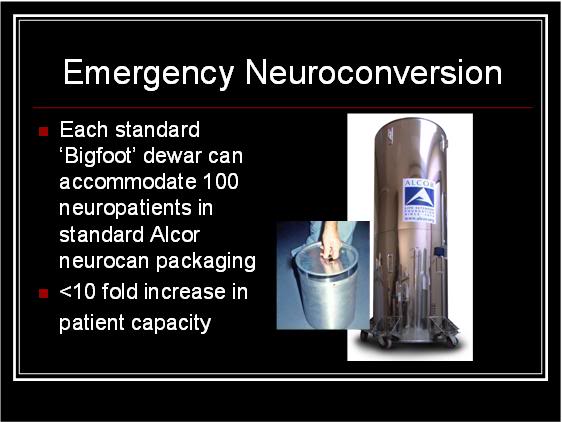 Figure 15: In the event of a prolonged existential crisis the current emergency survival plan calls for conversion of all whole body patients to neuro so that everyone can be cared for within 1 or 2 ITS Bigfoot units.
Figure 15: In the event of a prolonged existential crisis the current emergency survival plan calls for conversion of all whole body patients to neuro so that everyone can be cared for within 1 or 2 ITS Bigfoot units. Figure 16: The CryoMech LNP-40 liquid nitrogen (LN2) plant.
Figure 16: The CryoMech LNP-40 liquid nitrogen (LN2) plant.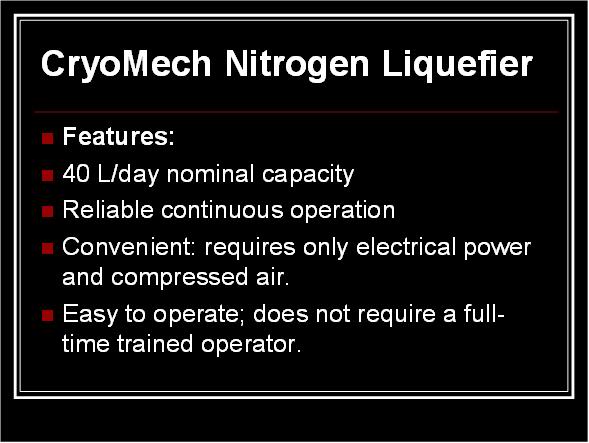 Figure 17: Specifications of the CryoMech LN2 plant.
Figure 17: Specifications of the CryoMech LN2 plant.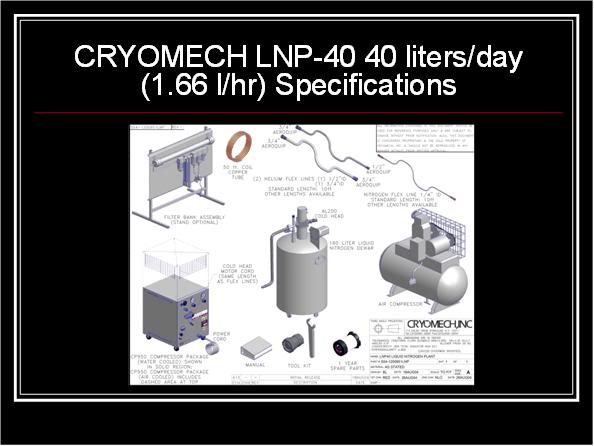 Figure 18: The elements which comprise the LNP-40 LN2 plant: molecular sieve membranes (upper left), air compressor which supplies air to nitrogen sieving membranes (middle right), LN2 collection and discharge dewar (center) and the Joule-Thompson nitrogen liquefier (lower left).
Figure 18: The elements which comprise the LNP-40 LN2 plant: molecular sieve membranes (upper left), air compressor which supplies air to nitrogen sieving membranes (middle right), LN2 collection and discharge dewar (center) and the Joule-Thompson nitrogen liquefier (lower left).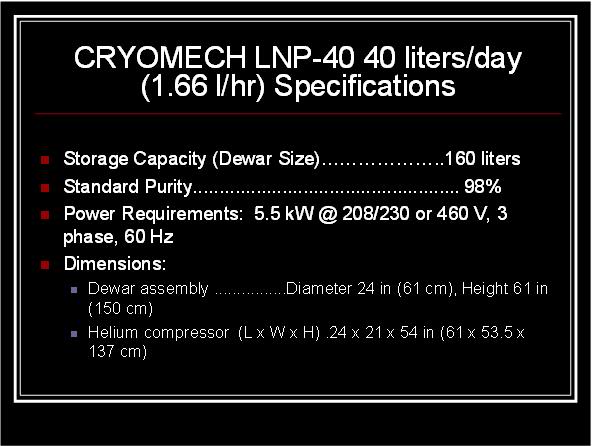 Figure 19: Additional specifications of the CryoMech LNP-40.
Figure 19: Additional specifications of the CryoMech LNP-40. Figure 20: The key elements (and their cost) of Mobile Facility’s solar power system.
Figure 20: The key elements (and their cost) of Mobile Facility’s solar power system. 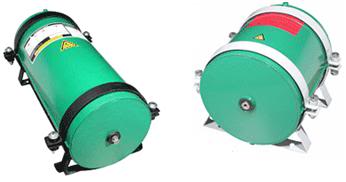 Figure 21: Supercapacitors of the kind used to store solar-generated electricity in the Alcor-B Facility to meet the “surge demand” of starting motors.
Figure 21: Supercapacitors of the kind used to store solar-generated electricity in the Alcor-B Facility to meet the “surge demand” of starting motors. Figure 22: The cost breakdown and key elements of the patient care essential portions of the Alcor-B Mobile, AZ Facility (2010 US dollars).
Figure 22: The cost breakdown and key elements of the patient care essential portions of the Alcor-B Mobile, AZ Facility (2010 US dollars).
 Figure 3: In the closing days of 2012the percentage of Americans receiving Federal Food Stamp assistance reached 16.25% of the population, up from 14.2% in June of 2011.[2] The continued deterioration of the US and the global economy coupled with major agricultural failures in the US as a result of drought and record summer heat throughout most of the nation are the factors most immediately responsible for this situation.
Figure 3: In the closing days of 2012the percentage of Americans receiving Federal Food Stamp assistance reached 16.25% of the population, up from 14.2% in June of 2011.[2] The continued deterioration of the US and the global economy coupled with major agricultural failures in the US as a result of drought and record summer heat throughout most of the nation are the factors most immediately responsible for this situation. Figure 4: The US median household income has been flat or in decline since 1999. Since 2007 the decline has been precipitous and sustained and this is consistent not with an economic recession, but rather with an economic depression.
Figure 4: The US median household income has been flat or in decline since 1999. Since 2007 the decline has been precipitous and sustained and this is consistent not with an economic recession, but rather with an economic depression.  Figure 5: Debt as a percentage of personal disposable (i.e., non-confiscated) income.
Figure 5: Debt as a percentage of personal disposable (i.e., non-confiscated) income.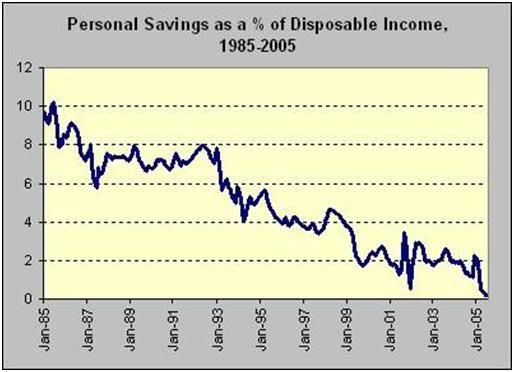 Figure 6: Personal savings as a percentage of disposable income from 1985 to 2005.
Figure 6: Personal savings as a percentage of disposable income from 1985 to 2005. Figure 7: The incredible disconnect between price, earnings, dividends and probable real value of shares; and of economic wealth as a whole. Data analysis and projection by TRP.
Figure 7: The incredible disconnect between price, earnings, dividends and probable real value of shares; and of economic wealth as a whole. Data analysis and projection by TRP. Figure 8: Purchasing power of the US dollar from 1900 to 2000.
Figure 8: Purchasing power of the US dollar from 1900 to 2000. Figure 9: The US National debt as of 2010, the last year that the TRP econometricians were certain that valid data was being released by the US Treasury Department.
Figure 9: The US National debt as of 2010, the last year that the TRP econometricians were certain that valid data was being released by the US Treasury Department.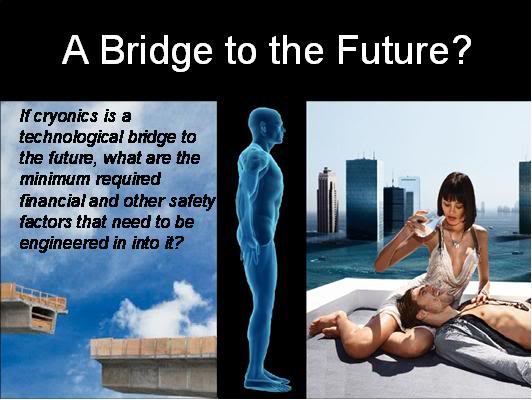 Figure 10: The analogy of cryonics as a bridge to the future, our future, implies that we must both build with enough safety factor to prevent collapse and anticipate existential crises that pose a genuine threat to its workability
Figure 10: The analogy of cryonics as a bridge to the future, our future, implies that we must both build with enough safety factor to prevent collapse and anticipate existential crises that pose a genuine threat to its workability Figure 11: Culicidae: Dipter in Dominican amber ~40 million years old.[3]
Figure 11: Culicidae: Dipter in Dominican amber ~40 million years old.[3] Figure 12: Buthidae: Scorpiones In Dominican Amber ~25-40 million years old.[3]
Figure 12: Buthidae: Scorpiones In Dominican Amber ~25-40 million years old.[3]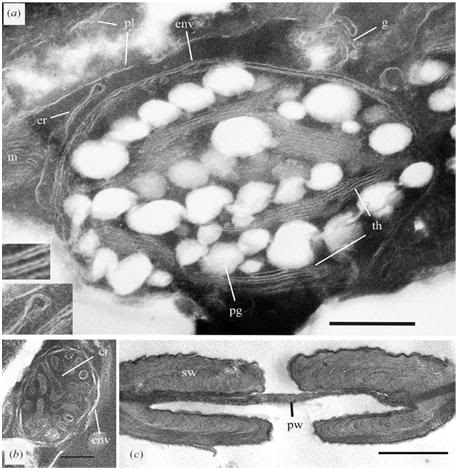 Figure 13: Cypress Plant Cell Ultra-structure: Baltic Amber ~45 million years old:
Figure 13: Cypress Plant Cell Ultra-structure: Baltic Amber ~45 million years old: 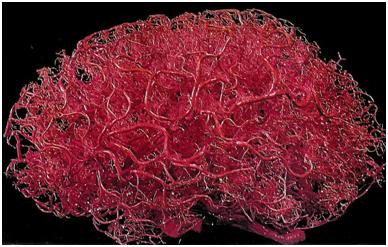 Figure 14: A corrosion cast of the circulatory system of the human brain. The extensive vascularization of the brain allows for use of the circulatory system as both a mass and heat exchanger. Gas perfusion of the circulatory system prior to cooling to vitrification temperatures leave it accessible during cryogenic storage should fixation and plastination become necessary as a fallback position to cryopreservation.
Figure 14: A corrosion cast of the circulatory system of the human brain. The extensive vascularization of the brain allows for use of the circulatory system as both a mass and heat exchanger. Gas perfusion of the circulatory system prior to cooling to vitrification temperatures leave it accessible during cryogenic storage should fixation and plastination become necessary as a fallback position to cryopreservation. Figure 15: The head of a fresh (~1.5 hrs post-mortem) human cadaver subjected to vitrification and then deep subzero fixation and plastination with Epon epoxy resin using the FFPS. Accelerated aging tests show both ultrastructural and molecular stability in the range of 1.5 to 2.0 million years.
Figure 15: The head of a fresh (~1.5 hrs post-mortem) human cadaver subjected to vitrification and then deep subzero fixation and plastination with Epon epoxy resin using the FFPS. Accelerated aging tests show both ultrastructural and molecular stability in the range of 1.5 to 2.0 million years. Figure 16: The Final Fallback Position System (FFPS) for the automated processing of cryopatient cephalons from the deep subzero state, to ambient temperature fixation and solidification (plastination).
Figure 16: The Final Fallback Position System (FFPS) for the automated processing of cryopatient cephalons from the deep subzero state, to ambient temperature fixation and solidification (plastination).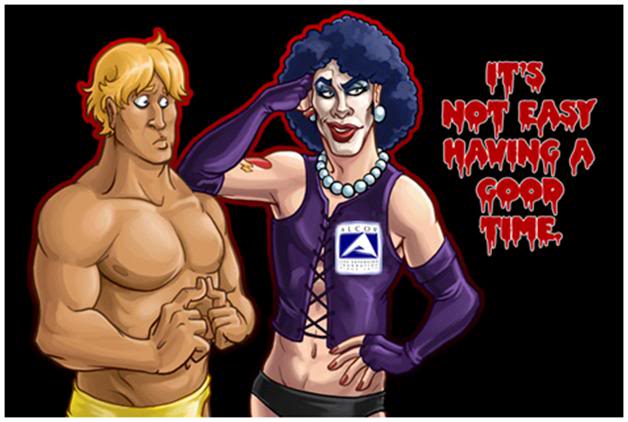 By Mike Darwin
By Mike Darwin Figure 1: Some of the homes on the 150 acre campus of the Alcor-B facility in Mobile, AZ that house Alcor-B staff, as well as Alcor-B members.
Figure 1: Some of the homes on the 150 acre campus of the Alcor-B facility in Mobile, AZ that house Alcor-B staff, as well as Alcor-B members. Figure 2: The Alcors are the second, smaller and dimmer companion stars to Mizar, the bright stars that comprise the crook in the handle of the Big Dipper constellation. In the Arab world of the 5th Century CE, Mizar’s much less bright (and more difficult to see) companion stars, Alcor-A and Alcor-B were used as tests for good vision. Only someone with the clearest and most acute visions could see the Alcor’s. Alcor-B was discovered early in 2011 using Project 1640m, which makes use of the Hale Telescope’s adaptive optics system. Project 1640 gives the Hale a view almost equal to what is possible in space. The instrument also has the ability to block out the light of a star, allowing faint objects located next to a star to be seen. The Hale, armed with Project 1640, was pointed at Alcor earlier this year and found that it isn’t a single star. Alcor has a small stellar companion that hadn’t been seen before: Alcor-B, a small, dim red dwarf star about one fourth the mass of our Sun. To see Alcor-B you must have the superior vision that only mastery of the most sophisticated technology allows. Alcor-B is thus a test for the clearest and most acute vision – vision capable of seeing things as they really are – not just as they appear to be.
Figure 2: The Alcors are the second, smaller and dimmer companion stars to Mizar, the bright stars that comprise the crook in the handle of the Big Dipper constellation. In the Arab world of the 5th Century CE, Mizar’s much less bright (and more difficult to see) companion stars, Alcor-A and Alcor-B were used as tests for good vision. Only someone with the clearest and most acute visions could see the Alcor’s. Alcor-B was discovered early in 2011 using Project 1640m, which makes use of the Hale Telescope’s adaptive optics system. Project 1640 gives the Hale a view almost equal to what is possible in space. The instrument also has the ability to block out the light of a star, allowing faint objects located next to a star to be seen. The Hale, armed with Project 1640, was pointed at Alcor earlier this year and found that it isn’t a single star. Alcor has a small stellar companion that hadn’t been seen before: Alcor-B, a small, dim red dwarf star about one fourth the mass of our Sun. To see Alcor-B you must have the superior vision that only mastery of the most sophisticated technology allows. Alcor-B is thus a test for the clearest and most acute vision – vision capable of seeing things as they really are – not just as they appear to be.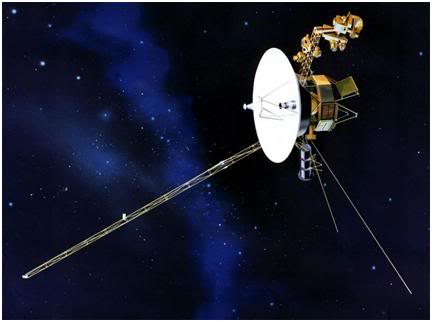 Figure 4: Conceived in the 1960s, a Grand Tour proposal to study the outer planets prompted NASA to begin work on a mission in the early 1970s. The development of the interplanetary probes coincided with an alignment of the planets, making possible a mission to the outer Solar System by taking advantage of the then-new technique, gravity assist. Utilizing gravity assists would enable a single probe to visit the four gas giants (Jupiter, Saturn, Uranus, and Neptune) while requiring a minimal amount of propellant and a shorter transit duration between planets. Originally, Voyager 1 was planned as Mariner 11 of the Mariner program however, due to congressional budget cuts, the mission was scaled back to be a flyby of Jupiter and Saturn, and renamed the Mariner Jupiter-Saturn probes. As the program progressed, the name was later changed to Voyager as the probe designs began to differ greatly from previous Mariner missions. [ http://history.nasa.gov/SP-4219/Chapter11.html]
Figure 4: Conceived in the 1960s, a Grand Tour proposal to study the outer planets prompted NASA to begin work on a mission in the early 1970s. The development of the interplanetary probes coincided with an alignment of the planets, making possible a mission to the outer Solar System by taking advantage of the then-new technique, gravity assist. Utilizing gravity assists would enable a single probe to visit the four gas giants (Jupiter, Saturn, Uranus, and Neptune) while requiring a minimal amount of propellant and a shorter transit duration between planets. Originally, Voyager 1 was planned as Mariner 11 of the Mariner program however, due to congressional budget cuts, the mission was scaled back to be a flyby of Jupiter and Saturn, and renamed the Mariner Jupiter-Saturn probes. As the program progressed, the name was later changed to Voyager as the probe designs began to differ greatly from previous Mariner missions. [ http://history.nasa.gov/SP-4219/Chapter11.html] Figure 6: Certificate awarded to Fred Chamberlain for his outstanding work on the Voyager Sun Sensor and Canopus Trackers. The certificate contains one of the unused sensor elements. [Images courtesy of Fred Chamerlain, III.]
Figure 6: Certificate awarded to Fred Chamberlain for his outstanding work on the Voyager Sun Sensor and Canopus Trackers. The certificate contains one of the unused sensor elements. [Images courtesy of Fred Chamerlain, III.]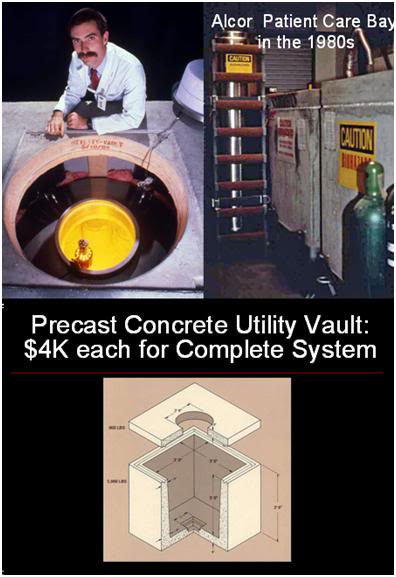 Figure 7: The first Alcor-B hardened patient protection structures were put in place in 28 years ago when Alcor-B had only 5 patients.[3]
Figure 7: The first Alcor-B hardened patient protection structures were put in place in 28 years ago when Alcor-B had only 5 patients.[3] Figure 8: Linda (L) and Fred (R) Chamberlain in the Control Room dome of the Titan-1 facility near Yuba City, CA in 1974.
Figure 8: Linda (L) and Fred (R) Chamberlain in the Control Room dome of the Titan-1 facility near Yuba City, CA in 1974. Figure 9: Economic destabilization, overpopulation and climate change appear to be interacting to greatly increase the risk of an impending global existential crisis.
Figure 9: Economic destabilization, overpopulation and climate change appear to be interacting to greatly increase the risk of an impending global existential crisis. Figure 10: The Mobile, AZ land parcel. as seen from State Route 238.
Figure 10: The Mobile, AZ land parcel. as seen from State Route 238. Figure 11: “We should be dead, but we aren’t. The goal is to walk so far ahead that the arrows can’t reach us anymore. And then, maybe, we can begin pulling some of them out.” – Beverly Rubik
Figure 11: “We should be dead, but we aren’t. The goal is to walk so far ahead that the arrows can’t reach us anymore. And then, maybe, we can begin pulling some of them out.” – Beverly Rubik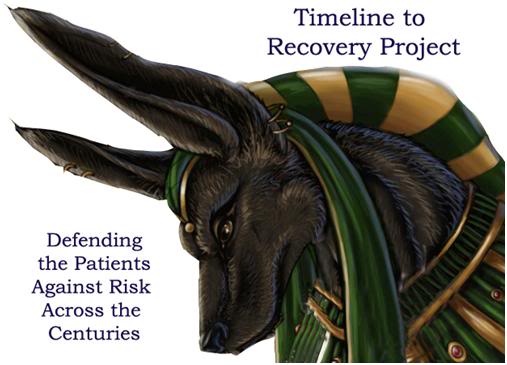 Figure 12: The Timeline to Recovery Project (TRP) began as an exercise to attempt to define the likely time course for the revival of various cohorts of Alcor-B patients, based upon the extent of ischemic and cryopreservation injury they are believed to have experienced. The TRP, whose symbol is Anapa (Anubis, the protector of the deceased and their tombs, in ancient Egypt) has become the principal defensive arm of Alcor-B in protecting the safety of its patients.
Figure 12: The Timeline to Recovery Project (TRP) began as an exercise to attempt to define the likely time course for the revival of various cohorts of Alcor-B patients, based upon the extent of ischemic and cryopreservation injury they are believed to have experienced. The TRP, whose symbol is Anapa (Anubis, the protector of the deceased and their tombs, in ancient Egypt) has become the principal defensive arm of Alcor-B in protecting the safety of its patients.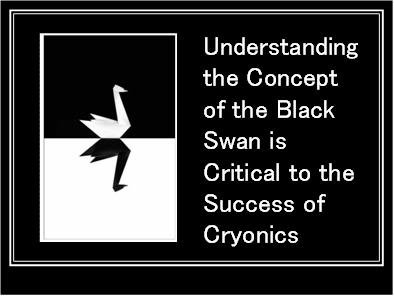 Figure 13: Black Swan Theory” calls attention to unexpected events of large magnitude and consequence and their dominant role in history. Such events, considered extreme outliers, collectively play vastly larger roles than regular occurrences. While Black Swan Theory has important implications, even for people living a currently normal lifetime of 75-100 years, its implications become more important when planning or carrying out undertaking that must continue, uninterrupted, across centuries.[4, 5] See also: http://papers.ssrn.com/sol3/papers.cfm?abstract_id=1864633
Figure 13: Black Swan Theory” calls attention to unexpected events of large magnitude and consequence and their dominant role in history. Such events, considered extreme outliers, collectively play vastly larger roles than regular occurrences. While Black Swan Theory has important implications, even for people living a currently normal lifetime of 75-100 years, its implications become more important when planning or carrying out undertaking that must continue, uninterrupted, across centuries.[4, 5] See also: http://papers.ssrn.com/sol3/papers.cfm?abstract_id=1864633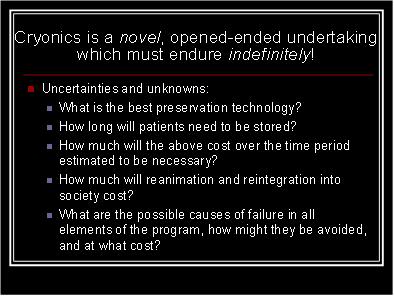 Figure 14: Some of the key factors considered by the Timeline to Recovery Groups in creating mathematical models for the time course to the reanimation of cryonics patients, as well as for the existential and other risks during the projected time interval.
Figure 14: Some of the key factors considered by the Timeline to Recovery Groups in creating mathematical models for the time course to the reanimation of cryonics patients, as well as for the existential and other risks during the projected time interval.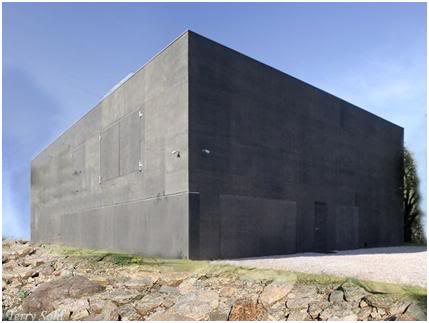
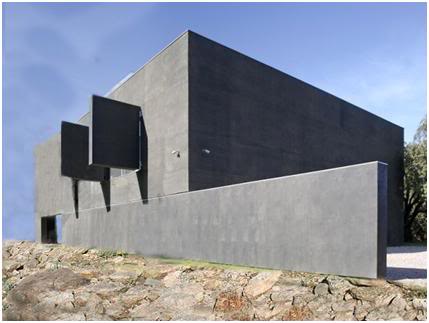

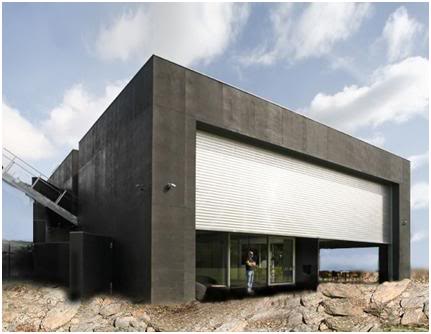
 Figure 15: The Alcor-B Facility surface terminator, which the staff affectionately call the “friendly fortress.”
Figure 15: The Alcor-B Facility surface terminator, which the staff affectionately call the “friendly fortress.” Alcor-B Cryopreservation Research Foundation (ABCRF)
Alcor-B Cryopreservation Research Foundation (ABCRF) Over the past five years the Alcor-B Cryobiology Research Foundation (Alcor-B) has been working to develop a fundamentally new and profoundly improved human cryopreservation technology platform. We have expended $3.5 million dollars on this effort and what we have developed is nothing less than a quantum advance in the quality of cryopreservation now available to Alcor-B patients who present for treatment under optimum conditions.
Over the past five years the Alcor-B Cryobiology Research Foundation (Alcor-B) has been working to develop a fundamentally new and profoundly improved human cryopreservation technology platform. We have expended $3.5 million dollars on this effort and what we have developed is nothing less than a quantum advance in the quality of cryopreservation now available to Alcor-B patients who present for treatment under optimum conditions.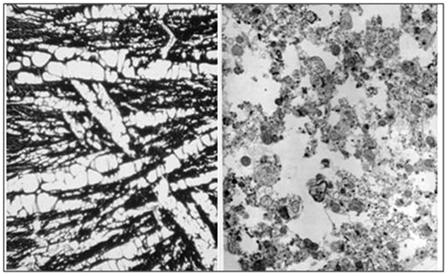 Figure 2: At left, above, is a light micrograph (400x) of the molecular layerof the rabbit cerebral cortex subjected to freezing to -79oC in the absence of cryoprotection (straight freezing). The tissue is compressed between blocks of ice that have osmotically extracted the intracellular water. At right is the molecular layer of rabbit cerebral cortex tissue (10,000x) following thawing and fixation after straight freezing. The ultrastructure of the tissue resembles that of a tissue homogenate, rather than that of the molecular layer of the cerebral cortex.[4]
Figure 2: At left, above, is a light micrograph (400x) of the molecular layerof the rabbit cerebral cortex subjected to freezing to -79oC in the absence of cryoprotection (straight freezing). The tissue is compressed between blocks of ice that have osmotically extracted the intracellular water. At right is the molecular layer of rabbit cerebral cortex tissue (10,000x) following thawing and fixation after straight freezing. The ultrastructure of the tissue resembles that of a tissue homogenate, rather than that of the molecular layer of the cerebral cortex.[4] 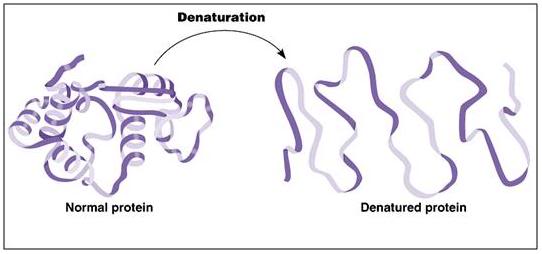 Figure 3: A ribbon model of a protein depicting the kind of conformational changes typically seen in protein denaturation as a result of freezing injury.
Figure 3: A ribbon model of a protein depicting the kind of conformational changes typically seen in protein denaturation as a result of freezing injury.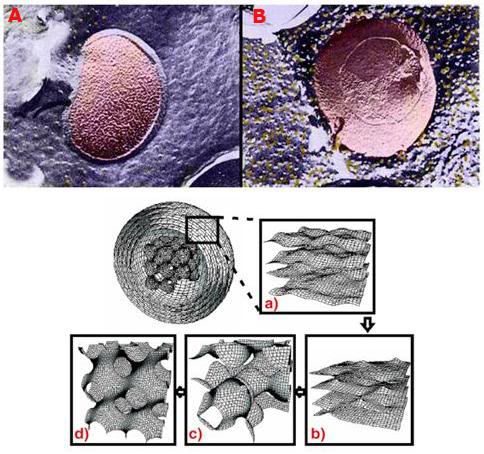 Figure 4: Above, top, shows a false-color rendering of the normal configuration of membrane lipids and the membrane protein sodium-potassium-ATPase in a bacterial cell membrane. The membrane exhibits a smooth, lamellar character, and there are only a few aggregated and displaced particles of protein evident (yellow granules). In B, at right above, there is evidence of an alteration in membrane structure after the cell has been incubated at ~ -6oC for 1 hour in the presence of 20% w/v dimethylsulfoxide (DMSO). The membrane has developed a pebbly appearance and there are many extruded granules of protein on the membrane surface. The lower illustration (above) is a computer rendering of various lipid phase transitions in a model system (Langmuir trough), some of which result in perforations of the normally lamellar membrane structure.
Figure 4: Above, top, shows a false-color rendering of the normal configuration of membrane lipids and the membrane protein sodium-potassium-ATPase in a bacterial cell membrane. The membrane exhibits a smooth, lamellar character, and there are only a few aggregated and displaced particles of protein evident (yellow granules). In B, at right above, there is evidence of an alteration in membrane structure after the cell has been incubated at ~ -6oC for 1 hour in the presence of 20% w/v dimethylsulfoxide (DMSO). The membrane has developed a pebbly appearance and there are many extruded granules of protein on the membrane surface. The lower illustration (above) is a computer rendering of various lipid phase transitions in a model system (Langmuir trough), some of which result in perforations of the normally lamellar membrane structure. Figure 5: Typical representation of how freezing proceeds in cells and tissues. Ice begins forming outside cells, forming crystals of pure water. The salts and other solids that were formerly dissolved in the crystallized water are forced into a progressively smaller volume of unfrozen solution. This increase in the concentration of solids dissolved in the extracellular fluid osmotically extracts water from the cells, causing them to shrink. At ~ -20oC no further water can be converted into ice and the interior of the cells remains in an unfrozen state – a highly concentrated solution of cell proteins and salts, from both inside and outside the cells. With further cooling this electrolyte gel will be converted to a crystal free glass at ~ -100oC
Figure 5: Typical representation of how freezing proceeds in cells and tissues. Ice begins forming outside cells, forming crystals of pure water. The salts and other solids that were formerly dissolved in the crystallized water are forced into a progressively smaller volume of unfrozen solution. This increase in the concentration of solids dissolved in the extracellular fluid osmotically extracts water from the cells, causing them to shrink. At ~ -20oC no further water can be converted into ice and the interior of the cells remains in an unfrozen state – a highly concentrated solution of cell proteins and salts, from both inside and outside the cells. With further cooling this electrolyte gel will be converted to a crystal free glass at ~ -100oC  re, -fy)because it completely suppresses the formation of damaging ice crystals during the cryopreservation process, as can be seen in Figure 6, below.
re, -fy)because it completely suppresses the formation of damaging ice crystals during the cryopreservation process, as can be seen in Figure 6, below.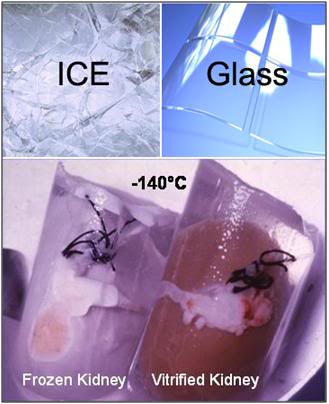 Figure 6: At bottom left a rabbit kidney that has been frozen following treatment with ~ 40% cryoprotectant agents. The kidney was submerged in solution that did not have enough cryoprotective agents present to allow it to vitrify. The kidney has a chalky, opaque appearance is due the presence of large amounts of ice in the tissue. At bottom right is a kidney that has been perfused and equilibrated with sufficient cryoprotectant to allow cooling to -140oC with no ice formation. Because this kidney has no ice crystals in it to refract light, it remains translucent and appears unfrozen – which is in fact the case – even though it has been converted to a solid, glassy state.[43] At top; Even in the everyday world, the difference between ice and glass is clearly visible when the two are compared side by side.
Figure 6: At bottom left a rabbit kidney that has been frozen following treatment with ~ 40% cryoprotectant agents. The kidney was submerged in solution that did not have enough cryoprotective agents present to allow it to vitrify. The kidney has a chalky, opaque appearance is due the presence of large amounts of ice in the tissue. At bottom right is a kidney that has been perfused and equilibrated with sufficient cryoprotectant to allow cooling to -140oC with no ice formation. Because this kidney has no ice crystals in it to refract light, it remains translucent and appears unfrozen – which is in fact the case – even though it has been converted to a solid, glassy state.[43] At top; Even in the everyday world, the difference between ice and glass is clearly visible when the two are compared side by side. Figure 7: Visual appearance of ice in a rabbit kidney that was cross-sectioned during rewarming. The kidney was perfused with a cryoprotective mixture called M22 at -22°C, cut in half, immersed in M22, vitrified at -135°C, and eventually re-warmed at ~1°C/min while being periodically photographed. Times (1:30 and 1:40) represent times in hours and minutes from the start of slow warming. The temperatures refer to ambient atmospheric temperatures near the kidney but not within the kidney itself. The upper panel shows the kidney at the point of maximum ice cross-sectional area, and the lower panel shows the kidney after complete ice melting. Both panels show the site of an inner medullary biopsy taken for differential scanning calorimetery in order to determine the actual concentration of cryoprotectants in the tissue with high precision. [http://cryoeuro.eu:8080/download/attachments/425990/FahyPhysicBiolAspectsRenalVitri2010.pdf?version=1&modificationDate=1285892563927]
Figure 7: Visual appearance of ice in a rabbit kidney that was cross-sectioned during rewarming. The kidney was perfused with a cryoprotective mixture called M22 at -22°C, cut in half, immersed in M22, vitrified at -135°C, and eventually re-warmed at ~1°C/min while being periodically photographed. Times (1:30 and 1:40) represent times in hours and minutes from the start of slow warming. The temperatures refer to ambient atmospheric temperatures near the kidney but not within the kidney itself. The upper panel shows the kidney at the point of maximum ice cross-sectional area, and the lower panel shows the kidney after complete ice melting. Both panels show the site of an inner medullary biopsy taken for differential scanning calorimetery in order to determine the actual concentration of cryoprotectants in the tissue with high precision. [http://cryoeuro.eu:8080/download/attachments/425990/FahyPhysicBiolAspectsRenalVitri2010.pdf?version=1&modificationDate=1285892563927] Figure 8: Twenty First Century Medicine’s M-22 vitrification solution contains 5 penetrating colligative cryoprotective agents as well as 6% of non-penetrating polymers – two of which are highly active ice-blocking molecules;
Figure 8: Twenty First Century Medicine’s M-22 vitrification solution contains 5 penetrating colligative cryoprotective agents as well as 6% of non-penetrating polymers – two of which are highly active ice-blocking molecules; 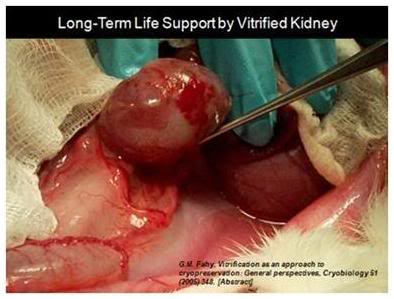 Figure 9: The first kidney to survive vitrification shortly before it was removed from the animal for evaluation after supporting its life as the sole kidney for 29 days.[5]
Figure 9: The first kidney to survive vitrification shortly before it was removed from the animal for evaluation after supporting its life as the sole kidney for 29 days.[5] Figure 10: Cryoprotection and cooling protocol used to achieve structural vitrification of the rabbit brain at 21st Century Medicine, Inc., CPA loading commences at a temperature of ~+4oC and continues at that temperature for ~ 60 minutes while the M-22 concentration is gradually increased to ~4 M. The temperature is then reduced to ~ -3oC while the CPA concentration is increased to ~ 8M. The total time required to achieve full equilibration of the brain with M-22 is ~ 180 minutes, after which the organ is immediately transferred to an air-blast cooler for very rapid cooling to ~ -135oC. [Image is courtesy of Brian Wowk, Ph.D., of 21st Century Medicine, Inc., http://www.21cm.com/]
Figure 10: Cryoprotection and cooling protocol used to achieve structural vitrification of the rabbit brain at 21st Century Medicine, Inc., CPA loading commences at a temperature of ~+4oC and continues at that temperature for ~ 60 minutes while the M-22 concentration is gradually increased to ~4 M. The temperature is then reduced to ~ -3oC while the CPA concentration is increased to ~ 8M. The total time required to achieve full equilibration of the brain with M-22 is ~ 180 minutes, after which the organ is immediately transferred to an air-blast cooler for very rapid cooling to ~ -135oC. [Image is courtesy of Brian Wowk, Ph.D., of 21st Century Medicine, Inc., http://www.21cm.com/]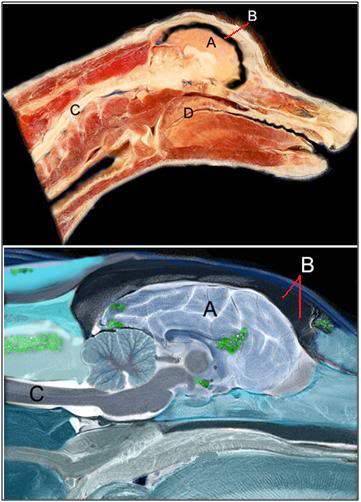 Figure 11: Dog brains subjected to NVT under optimum laboratory conditions show no visual evidence of ice formation. However, when false-color, polarized light imaging is used, areas of minimal ice formation can be seen. Measurements of the ice content in the brain regions seen to contain ice (as above) using differential scanning calorimetery typically show ice formation in the range of 4-12% of the tissues volume. A=brain, B=space from cryoprotectant-induced brain dehydration, C=spinal cord, D=soft palate.
Figure 11: Dog brains subjected to NVT under optimum laboratory conditions show no visual evidence of ice formation. However, when false-color, polarized light imaging is used, areas of minimal ice formation can be seen. Measurements of the ice content in the brain regions seen to contain ice (as above) using differential scanning calorimetery typically show ice formation in the range of 4-12% of the tissues volume. A=brain, B=space from cryoprotectant-induced brain dehydration, C=spinal cord, D=soft palate. Figure 12: Sections of the experimental animals were cut at deep subzero temperatures using a specially modified
Figure 12: Sections of the experimental animals were cut at deep subzero temperatures using a specially modified 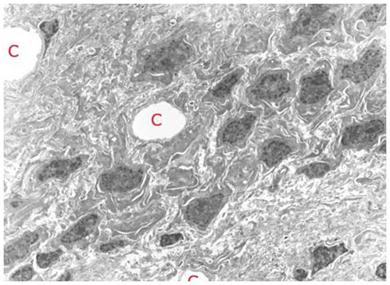 Figure 13: TEM of rabbit cerebral cortex gray matter (~ 15,000x) subjected to vitrification, rewarming and perfusion fixation using M-22 and the perfusion protocol shown in Figure 10, above. The extensive dehydration induced by cryoprotective loading makes it difficult to visualize the finer elements of the ultrastructure such as vesicles and microtubules. The overall appearance of tissue in terms of the larger structural elements and their relationship to each other is apparently normal. [Image is courtesy of Brian Wowk, Ph.D., of 21st Century Medicine, Inc., http://www.21cm.com/]
Figure 13: TEM of rabbit cerebral cortex gray matter (~ 15,000x) subjected to vitrification, rewarming and perfusion fixation using M-22 and the perfusion protocol shown in Figure 10, above. The extensive dehydration induced by cryoprotective loading makes it difficult to visualize the finer elements of the ultrastructure such as vesicles and microtubules. The overall appearance of tissue in terms of the larger structural elements and their relationship to each other is apparently normal. [Image is courtesy of Brian Wowk, Ph.D., of 21st Century Medicine, Inc., http://www.21cm.com/]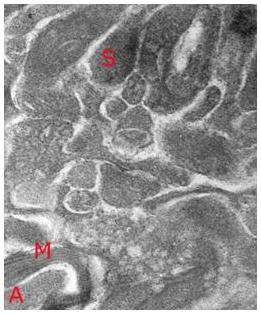 Figure 14: High magnification TEM (~ 40,000x) of vitrified rabbit brain tissue discloses the presence of difficult to visualize fine structures – in this case a synapse (S) with synaptic vesicles visible as dark densities in the synaptic bouton and a small myleinated (M) axon containing condensed axoplasm (A). Importantly, the topographical and structural relation of the synapse to the surrounding structures appears intact. [Image is courtesy of Brian Wowk, Ph.D., of 21st Century Medicine, Inc.,
Figure 14: High magnification TEM (~ 40,000x) of vitrified rabbit brain tissue discloses the presence of difficult to visualize fine structures – in this case a synapse (S) with synaptic vesicles visible as dark densities in the synaptic bouton and a small myleinated (M) axon containing condensed axoplasm (A). Importantly, the topographical and structural relation of the synapse to the surrounding structures appears intact. [Image is courtesy of Brian Wowk, Ph.D., of 21st Century Medicine, Inc., 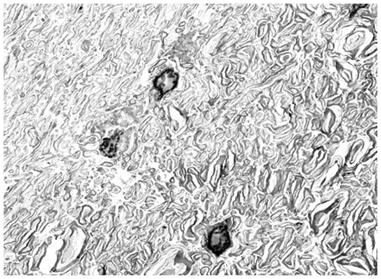 Figure 15: TEM of rabbit cerebral cortex white matter (15,000x) subjected to vitrification, rewarming and perfusion fixation using M-22 and the perfusion protocol shown in Figure 10, above. There is severe dehydration of the axoplasm and separation between some of the layers of myelin. There is no evidence of ice formation, and all structural changes appear to be a consequence of CPA-induced dehydration. These changes are reversible with controlled removal of CPA and return of the tissue to incubating medium (see Figure 17, below). [Image is courtesy of Brian Wowk, Ph.D., of 21st Century Medicine, Inc., http://www.21cm.com/]
Figure 15: TEM of rabbit cerebral cortex white matter (15,000x) subjected to vitrification, rewarming and perfusion fixation using M-22 and the perfusion protocol shown in Figure 10, above. There is severe dehydration of the axoplasm and separation between some of the layers of myelin. There is no evidence of ice formation, and all structural changes appear to be a consequence of CPA-induced dehydration. These changes are reversible with controlled removal of CPA and return of the tissue to incubating medium (see Figure 17, below). [Image is courtesy of Brian Wowk, Ph.D., of 21st Century Medicine, Inc., http://www.21cm.com/]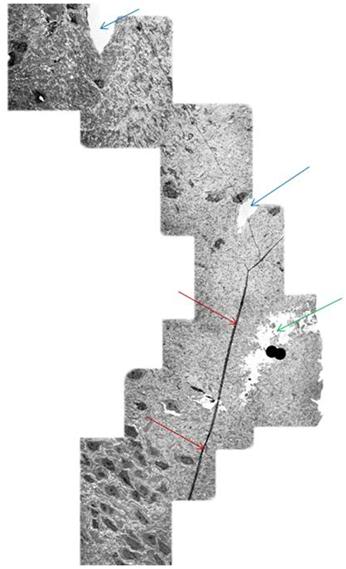 Figure 16: Mosaic of TEM’s demonstrating continuity of a long axon (red arrows) in a rabbit brain subjected to vitrification, rewarming and perfusion fixation using M-22 and the perfusion protocol shown in Figure 10, above. The tear in the tissue (green arrow) is believed to be a processing artifact. Two capillaries visible near the middle and top of the mosaic (blue arrows). [Image is courtesy of Brian Wowk, Ph.D., of 21st Century Medicine, Inc., http://www.21cm.com/]
Figure 16: Mosaic of TEM’s demonstrating continuity of a long axon (red arrows) in a rabbit brain subjected to vitrification, rewarming and perfusion fixation using M-22 and the perfusion protocol shown in Figure 10, above. The tear in the tissue (green arrow) is believed to be a processing artifact. Two capillaries visible near the middle and top of the mosaic (blue arrows). [Image is courtesy of Brian Wowk, Ph.D., of 21st Century Medicine, Inc., http://www.21cm.com/]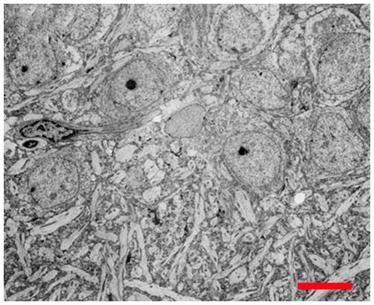 Figure 17: Hippocampal CA4 cells following recovery from vitrification using a fully reversible, viability conserving technique. Following rewarming and unloading of the CPA the tissue was incubated in artificial cerebrospinal fluid at 35oC for >60 min before being fixed in low-osmolality Karnovsky’s and examined by TEM.[6]
Figure 17: Hippocampal CA4 cells following recovery from vitrification using a fully reversible, viability conserving technique. Following rewarming and unloading of the CPA the tissue was incubated in artificial cerebrospinal fluid at 35oC for >60 min before being fixed in low-osmolality Karnovsky’s and examined by TEM.[6] 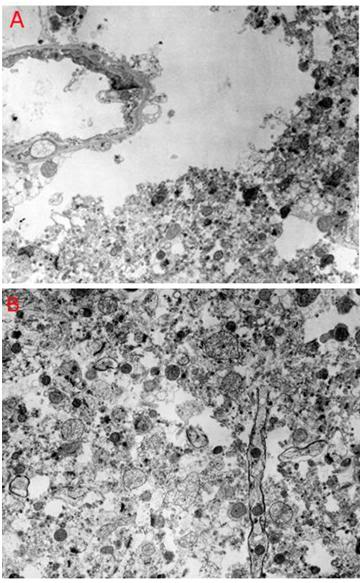 Figure 18: Feline cerebral cortex frozen, thawed and fixed in the presence of 4 M glycerol after 30 minutes of normothermic ischemia, followed by 24 hours of cold ischemia at ~2-4oC. There was severe disruption of the tissue fine structure by ice (A,B), in addition to changes associated with ischemia such as mitochondrial swelling and blebbing of the endothelial cells (A). [TEMs by the author.][7]
Figure 18: Feline cerebral cortex frozen, thawed and fixed in the presence of 4 M glycerol after 30 minutes of normothermic ischemia, followed by 24 hours of cold ischemia at ~2-4oC. There was severe disruption of the tissue fine structure by ice (A,B), in addition to changes associated with ischemia such as mitochondrial swelling and blebbing of the endothelial cells (A). [TEMs by the author.][7] 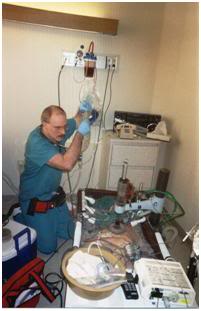 Figure 19: Ideally, immediately following the pronouncement of medico-legal death, circulation and respiration are restored by mechanical means while the patient is rapidly cooled. Medications to protect the brain against damage from lack of blood flow (ischemic injury) are also administered at this time. A new technique for cooling employing chilled liquid perfluorocarbon cycled in and out of the patient’s lungs allows for even faster cooling of the brain (~0.5 oC/min).[8]
Figure 19: Ideally, immediately following the pronouncement of medico-legal death, circulation and respiration are restored by mechanical means while the patient is rapidly cooled. Medications to protect the brain against damage from lack of blood flow (ischemic injury) are also administered at this time. A new technique for cooling employing chilled liquid perfluorocarbon cycled in and out of the patient’s lungs allows for even faster cooling of the brain (~0.5 oC/min).[8] Figure 20: The Alcor-B extracorporeal membrane oxygenation, or ECMO cart, being used to provide circulation, gas exchange and cooling to a cryonics patient who has experienced medico-legal death in his home, under the care of home hospice.
Figure 20: The Alcor-B extracorporeal membrane oxygenation, or ECMO cart, being used to provide circulation, gas exchange and cooling to a cryonics patient who has experienced medico-legal death in his home, under the care of home hospice.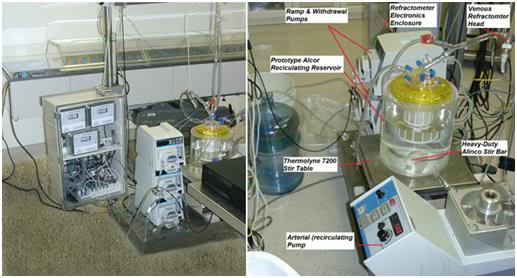 Figure 21: At left above are the process control refractometrs (inside perspex fronted cabinet) which monitor the concentration of cryoprotectants going into (arterial) and coming out of (venous) the patient. The data stream from these refractometers feeds into the cryoprotective perfusion and cooling control computer. Next to the refractometers are the cryoprotectant addition pump and the recirculating perfusate withdrawal pump. The third pump is for ‘cardiotomy suction’ to recover perfusate leaking into the chest wound and return it to the circuit. At right above is the recirculating and mixing reservoir (yellow top) sitting atop a magnetic stirring table. A magnetically driven stir bar mixes the concentrated cryoprotectant solution with the much more dilute perfusate being recirculated through the patient.
Figure 21: At left above are the process control refractometrs (inside perspex fronted cabinet) which monitor the concentration of cryoprotectants going into (arterial) and coming out of (venous) the patient. The data stream from these refractometers feeds into the cryoprotective perfusion and cooling control computer. Next to the refractometers are the cryoprotectant addition pump and the recirculating perfusate withdrawal pump. The third pump is for ‘cardiotomy suction’ to recover perfusate leaking into the chest wound and return it to the circuit. At right above is the recirculating and mixing reservoir (yellow top) sitting atop a magnetic stirring table. A magnetically driven stir bar mixes the concentrated cryoprotectant solution with the much more dilute perfusate being recirculated through the patient. 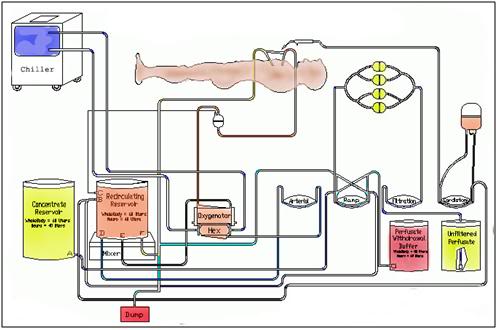 Figure 22: A schematic diagram of the extracorporeal circuit used to replace ~60% of the water in a cryonics patient’s body with vitrification (cryoprotective) drugs.
Figure 22: A schematic diagram of the extracorporeal circuit used to replace ~60% of the water in a cryonics patient’s body with vitrification (cryoprotective) drugs.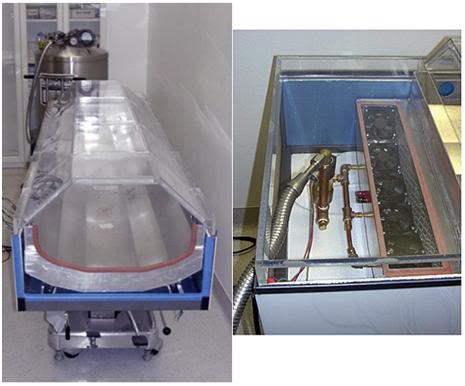 Figure 23: At left, above, is the controlled temperature enclosure for cryoprotective perfusion of the patient and cooling to -150oC. The contoured aluminum module on which the patient rests is the bottom half of the protective pod that will enclose the patient during long-term cryogenic storage. Once perfusion and deep cooling are complete, the pre-cooled upper half of the patient pod is attached and the patient is transferred to long-term storage. At right, above, is close-up view of the liquid nitrogen (LN2) vapor circulating fans and the LN2 dispensing manifold. A solenoid, under computer control, open and closes the valve to the LN2 reservoir to maintain the temperature at the desired point.
Figure 23: At left, above, is the controlled temperature enclosure for cryoprotective perfusion of the patient and cooling to -150oC. The contoured aluminum module on which the patient rests is the bottom half of the protective pod that will enclose the patient during long-term cryogenic storage. Once perfusion and deep cooling are complete, the pre-cooled upper half of the patient pod is attached and the patient is transferred to long-term storage. At right, above, is close-up view of the liquid nitrogen (LN2) vapor circulating fans and the LN2 dispensing manifold. A solenoid, under computer control, open and closes the valve to the LN2 reservoir to maintain the temperature at the desired point.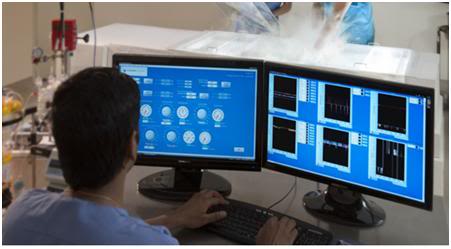 Figure 24: Once the patient is connected to the cryoprotective perfusion system and flushed with B1 carrier solution, the control of all parameters of cryoprotective perfusion is assumed by the computer. Arterial and venous pressures, perfusate flow rate, cryoprotectant concentration increase and all temperatures are under computer control. This is necessary because the rapid changes to these parameters that are required to minimize perfusion time and reduce toxicity by keeping the patient’s temperature just above the freezing point of the cryoprotectant-water mixture in his tissues cannot be managed by humans – we’re too slow – and too easily distracted.
Figure 24: Once the patient is connected to the cryoprotective perfusion system and flushed with B1 carrier solution, the control of all parameters of cryoprotective perfusion is assumed by the computer. Arterial and venous pressures, perfusate flow rate, cryoprotectant concentration increase and all temperatures are under computer control. This is necessary because the rapid changes to these parameters that are required to minimize perfusion time and reduce toxicity by keeping the patient’s temperature just above the freezing point of the cryoprotectant-water mixture in his tissues cannot be managed by humans – we’re too slow – and too easily distracted.  Figure 25: Long-term cryogenic storage is carried out using a newly developed technology known as intermediate temperature storage (ITS). ITS holds the patient at a temperature of ~ -150oC, which is a sufficiently low temperature to stop all biochemical activity, and yet not so cold that it could cause fracturing in the patient’s tissues.
Figure 25: Long-term cryogenic storage is carried out using a newly developed technology known as intermediate temperature storage (ITS). ITS holds the patient at a temperature of ~ -150oC, which is a sufficiently low temperature to stop all biochemical activity, and yet not so cold that it could cause fracturing in the patient’s tissues.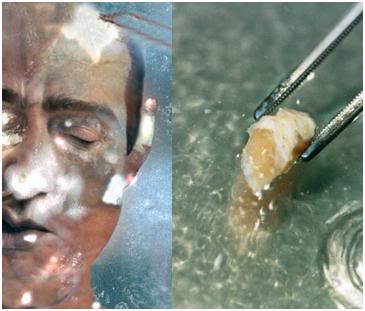 Figure 26: Quality control and validation of our procedures is critically important to Alcor-B. For that reason we treat each human case as an experiment; an undertaking to be carefully documented and to be learned from. At left above is an Alcor-B patient following cooling to -150oC. The chalky white areas present on the skin are areas where ice formation has occurred. The rest of the patient’s skin appears somewhat translucent and is not frozen, but rather is vitrified – converted into a glassy state. At right is a section of spinal cord taken from an Alcor-B neuropatient (i.e., a head-only patient). This section of cord is completely free of ice and demonstrated normal ultrastructure for tissue subjected to NVT, as can be seen in Figure 28, below.
Figure 26: Quality control and validation of our procedures is critically important to Alcor-B. For that reason we treat each human case as an experiment; an undertaking to be carefully documented and to be learned from. At left above is an Alcor-B patient following cooling to -150oC. The chalky white areas present on the skin are areas where ice formation has occurred. The rest of the patient’s skin appears somewhat translucent and is not frozen, but rather is vitrified – converted into a glassy state. At right is a section of spinal cord taken from an Alcor-B neuropatient (i.e., a head-only patient). This section of cord is completely free of ice and demonstrated normal ultrastructure for tissue subjected to NVT, as can be seen in Figure 28, below.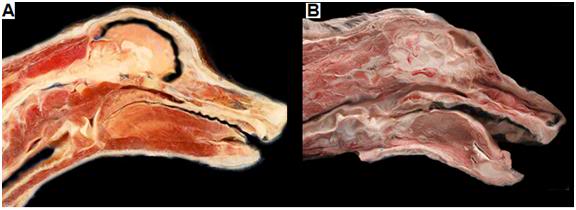 Figure 27: At left above is a dog treated with NVT under ideal conditions of 5 minutes of cardiac arrest at normal body temperature followed by 45 minutes and closed-chest CPS and then extracorporeal cooling to 10 oC. Cryoprotective perfusion was then carried out followed by cooling to -150oC and solidification. There is no visible ice and the animal presents the appearance of being uniformly equilibrated with cryoprotective solution. At right, above, is a dog which experienced cardiac arrest followed by cooling with ice bags. Blood washout and cryoprotective perfusion were not initiated until 18 hours after the start of both cardiac arrest and external cooling. This animal underwent freezing and the distribution of cryoprotective agents was very inhomogeneous in the brain and in the skeletal muscle and other tissues.
Figure 27: At left above is a dog treated with NVT under ideal conditions of 5 minutes of cardiac arrest at normal body temperature followed by 45 minutes and closed-chest CPS and then extracorporeal cooling to 10 oC. Cryoprotective perfusion was then carried out followed by cooling to -150oC and solidification. There is no visible ice and the animal presents the appearance of being uniformly equilibrated with cryoprotective solution. At right, above, is a dog which experienced cardiac arrest followed by cooling with ice bags. Blood washout and cryoprotective perfusion were not initiated until 18 hours after the start of both cardiac arrest and external cooling. This animal underwent freezing and the distribution of cryoprotective agents was very inhomogeneous in the brain and in the skeletal muscle and other tissues.  Figure 28: Above are gray (left) and white (right) matter from the spinal cord of an Alcor-B neuropatient who underwent NVT under optimum conditions. The gray matter (left) shows two normal appearing capillaries and dehydrated, but otherwise normal fine structure. The white matter (right) shows more dehydration from cryoprotection. The interiors of the axons (axoplasm) are shrunken and the myelin sheaths that surround the axons have a rumpled and somewhat unraveled appearance. Alcor-B is currently conducting research to try to overcome these problems. Despite these admittedly undesirable alterations, the overall structure of the spinal cord appears beautifully preserved.
Figure 28: Above are gray (left) and white (right) matter from the spinal cord of an Alcor-B neuropatient who underwent NVT under optimum conditions. The gray matter (left) shows two normal appearing capillaries and dehydrated, but otherwise normal fine structure. The white matter (right) shows more dehydration from cryoprotection. The interiors of the axons (axoplasm) are shrunken and the myelin sheaths that surround the axons have a rumpled and somewhat unraveled appearance. Alcor-B is currently conducting research to try to overcome these problems. Despite these admittedly undesirable alterations, the overall structure of the spinal cord appears beautifully preserved.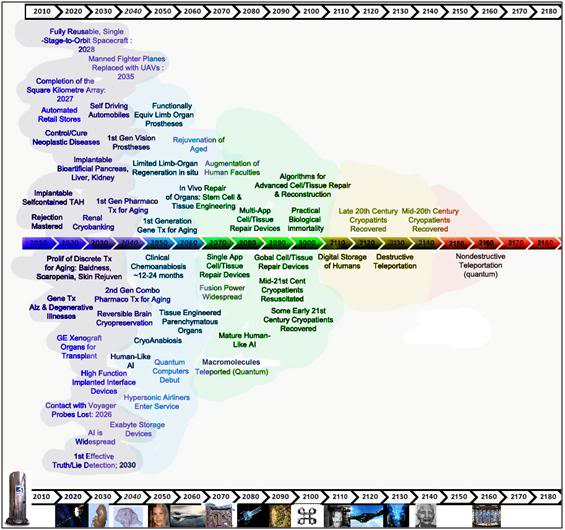 Figure 29: Patients treated with NVT & ITS may be recoverable before this century’s end using biologically derived organogenesis and tissue repair technologies. This offers considerable risk reduction and improved odds that cryopreservation will be successful.
Figure 29: Patients treated with NVT & ITS may be recoverable before this century’s end using biologically derived organogenesis and tissue repair technologies. This offers considerable risk reduction and improved odds that cryopreservation will be successful. 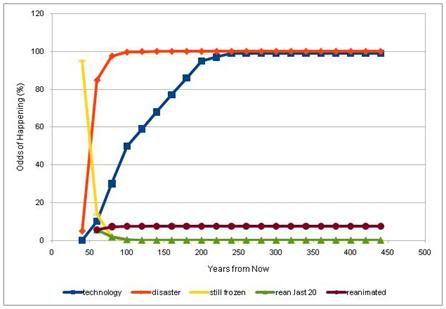 Figure 30: Using the “Cryonics Calculator” developed by Brook Norton (http://www.cryonicscalculator.com/), and assuming a very conservative risk of organizational failure of 30% for the first two decades of cryopreservation, 75% for the second 20 year interval, 10% for the third 20 year interval, 3% for the fourth 20 year interval and 2% for last 20 year interval the probability of being recovered from cryopreservation is only 17%. [This assumes that you are currently 50 years old and will be cryopreserved at age 90 and that you have a 5% risk of autopsy, or other catastrophic destruction of your remains prior to cryopreservation.]
Figure 30: Using the “Cryonics Calculator” developed by Brook Norton (http://www.cryonicscalculator.com/), and assuming a very conservative risk of organizational failure of 30% for the first two decades of cryopreservation, 75% for the second 20 year interval, 10% for the third 20 year interval, 3% for the fourth 20 year interval and 2% for last 20 year interval the probability of being recovered from cryopreservation is only 17%. [This assumes that you are currently 50 years old and will be cryopreserved at age 90 and that you have a 5% risk of autopsy, or other catastrophic destruction of your remains prior to cryopreservation.]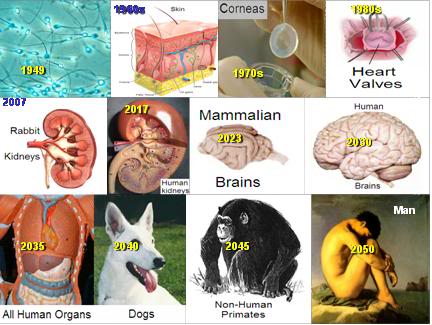 Figure 31: Alcor-B’s timeline to achieving fully reversible suspended animation for both the human brain and the intact human.
Figure 31: Alcor-B’s timeline to achieving fully reversible suspended animation for both the human brain and the intact human.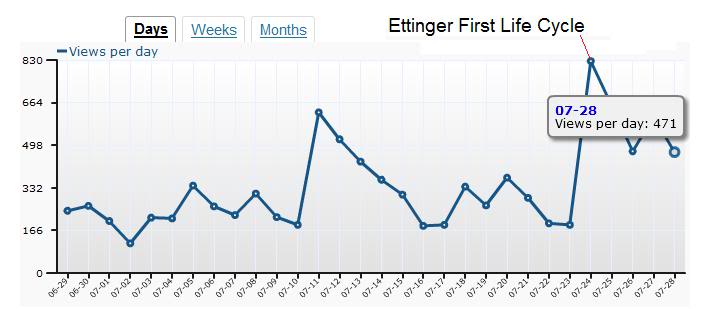
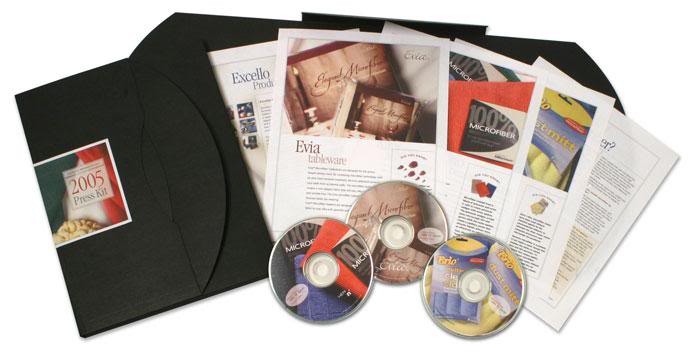

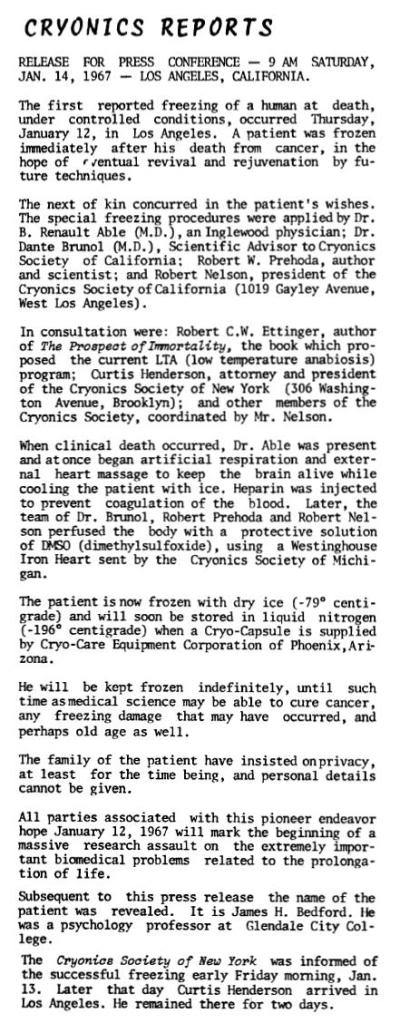


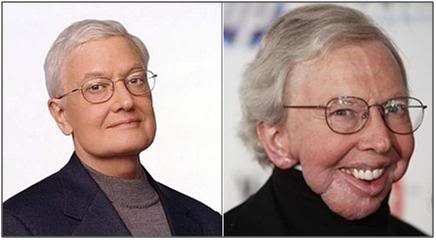 Figure 1: Film critic Roger Ebert suffered from papillary thyroid cancer in 2002. He initially chose conservative treatment options which left his appearance intact and his ability to speak unimpaired. The tumor recurred and invaded his salivary gland with metastases to the lymph nodes of the neck. The only procedure which offers any reasonable proven prospect of a cure (~ 5%) is radical neck surgery in conjunction with intensive and relatively wide-field radiation (typically neutron beam) of the neck. The black turtleneck which Ebert now wears covers the cervical support collar which helps hold his head erect. Radical neck dissection typically removes so much muscle (and other structure) that the patient cannot hold his head erect. Ebert has no functioning larynx and cannot eat using his mouth – he is tube fed via a feeding gastrostomy. Despite these horrific procedures and the attendant suffering, he has returned to productive work. Few patients with head/neck cancers choose this treatment option, even when the alternative is certain death. Even now, statistically, Ebert’s chances of survival into old age are small.
Figure 1: Film critic Roger Ebert suffered from papillary thyroid cancer in 2002. He initially chose conservative treatment options which left his appearance intact and his ability to speak unimpaired. The tumor recurred and invaded his salivary gland with metastases to the lymph nodes of the neck. The only procedure which offers any reasonable proven prospect of a cure (~ 5%) is radical neck surgery in conjunction with intensive and relatively wide-field radiation (typically neutron beam) of the neck. The black turtleneck which Ebert now wears covers the cervical support collar which helps hold his head erect. Radical neck dissection typically removes so much muscle (and other structure) that the patient cannot hold his head erect. Ebert has no functioning larynx and cannot eat using his mouth – he is tube fed via a feeding gastrostomy. Despite these horrific procedures and the attendant suffering, he has returned to productive work. Few patients with head/neck cancers choose this treatment option, even when the alternative is certain death. Even now, statistically, Ebert’s chances of survival into old age are small.
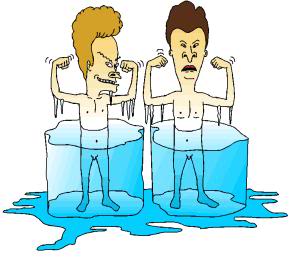

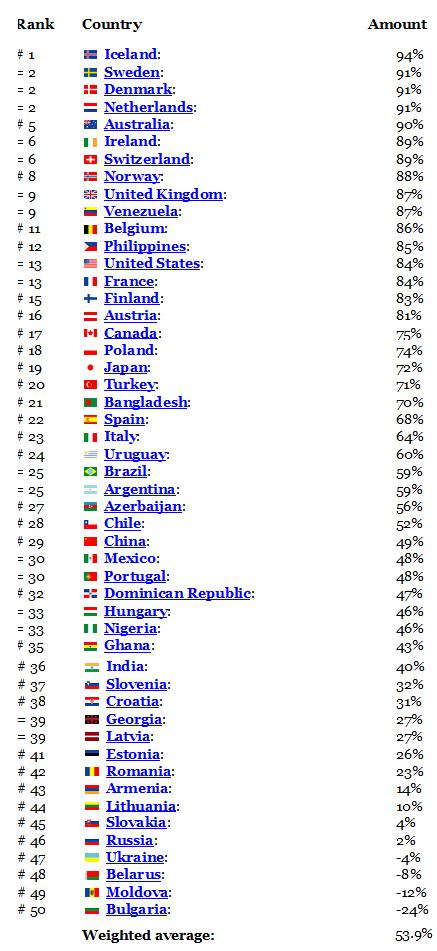 DEFINITION: This statistic is compiled from responses to the survey question: “Taking all things together, would you say you are: very happy, quite happy, not very happy, or not at all happy?”. The “Happiness (net)” statistic was obtained via the following formula: the percentage of people who rated themselves as either “quite happy” or “very happy” minus the percentage of people who rated themselves as either “not very happy” or “not at all happy”.
DEFINITION: This statistic is compiled from responses to the survey question: “Taking all things together, would you say you are: very happy, quite happy, not very happy, or not at all happy?”. The “Happiness (net)” statistic was obtained via the following formula: the percentage of people who rated themselves as either “quite happy” or “very happy” minus the percentage of people who rated themselves as either “not very happy” or “not at all happy”.  Figure 4: Your life and future prospects can still be grim and relatively hopeless and yet your evaluation of your satisfaction with life vary dramatically depending upon whether you have a full belly, or even if you’ve had a meal in the past few hours.
Figure 4: Your life and future prospects can still be grim and relatively hopeless and yet your evaluation of your satisfaction with life vary dramatically depending upon whether you have a full belly, or even if you’ve had a meal in the past few hours.





 Robert Ettinger devoted his life to providing an option that could possibly lead to eternal life with the help of science.
Robert Ettinger devoted his life to providing an option that could possibly lead to eternal life with the help of science. Body of Robert Ettinger committed to his own institute
Body of Robert Ettinger committed to his own institute Placed alongside his mother and two wives
Placed alongside his mother and two wives Robert Ettinger, from Clinton Township, Detroit, became the 106th person to be stored at the Cryonics Institute which he founded in 1976.
Robert Ettinger, from Clinton Township, Detroit, became the 106th person to be stored at the Cryonics Institute which he founded in 1976.
 But when nothing seemed to be happening, he wrote a book in 1964 entitled ‘The Prospect Of Immortality’, introducing the concept of cryonics.
But when nothing seemed to be happening, he wrote a book in 1964 entitled ‘The Prospect Of Immortality’, introducing the concept of cryonics. Cryonics is the low-temperature preservation of humans and animals with the hope that they will be able to be ‘brought back to life’ when science is able to do so.
Cryonics is the low-temperature preservation of humans and animals with the hope that they will be able to be ‘brought back to life’ when science is able to do so. Robert Ettinger, pioneer of the cryonics movement
Robert Ettinger, pioneer of the cryonics movement Ettinger (right) entertains visitors (Image: Cryonics Institute)
Ettinger (right) entertains visitors (Image: Cryonics Institute) (Image: Sipa Press/Rex Features)
(Image: Sipa Press/Rex Features) Many living animals have evolved tricks to survive sub-zero temperatures and thaw out after temporary periods of icy paralysis. And scientists have made significant headway in freezing living tissues and even whole human organs for medical purposes. To the disappointment of Jurassic Park fans and enthusiasts of prehistoric life, the notion of resurrecting a frozen mammoth has not panned out so far.
Many living animals have evolved tricks to survive sub-zero temperatures and thaw out after temporary periods of icy paralysis. And scientists have made significant headway in freezing living tissues and even whole human organs for medical purposes. To the disappointment of Jurassic Park fans and enthusiasts of prehistoric life, the notion of resurrecting a frozen mammoth has not panned out so far. Tuesday 26 July 2011 14.44 BST
Tuesday 26 July 2011 14.44 BST
 Robert Ettinger, former president of Cryonics Institute is shown at the institute facilities in Clinton Township, Mich., July 29, 2002.
Robert Ettinger, former president of Cryonics Institute is shown at the institute facilities in Clinton Township, Mich., July 29, 2002. Robert Ettinger
Robert Ettinger Robert Chester Wilson Ettinger.
Robert Chester Wilson Ettinger.
 Robert C.W. Ettinger, who famously said that death was for the unprepared and the unimaginative, died on Saturday. But the physics teacher and science fiction writer may be coming back — his family froze his body cryogenically.
Robert C.W. Ettinger, who famously said that death was for the unprepared and the unimaginative, died on Saturday. But the physics teacher and science fiction writer may be coming back — his family froze his body cryogenically. Courtesy Photo Robert Ettinger
Courtesy Photo Robert Ettinger
 Robert Ettinger, pioneer of the cryonics movement that advocates freezing the dead in the hope medical technology will enable them to live again some day, has died. He was 92.
Robert Ettinger, pioneer of the cryonics movement that advocates freezing the dead in the hope medical technology will enable them to live again some day, has died. He was 92.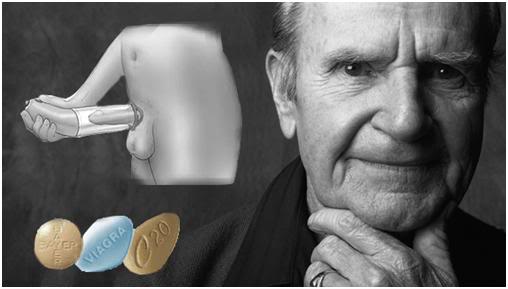 By Mike Darwin
By Mike Darwin Figure 1: How is it that what both men and women once reveled in and found unspeakably beautiful in youth, they regard with indifference or even revulsion in middle and old age?
Figure 1: How is it that what both men and women once reveled in and found unspeakably beautiful in youth, they regard with indifference or even revulsion in middle and old age? Figure 2: The data above reflect the real, measured life expectancy and sexually active life expectancy inUS men and women based on data from a national survey of midlife development in the United States (MIDUS). Lindau, ST, Gavrilova,N. Sex, health, and years of sexually active life gained due to good health: evidence from two US population based cross sectional surveys of ageing BMJ 2010; 340:c810: http://www.bmj.com/content/340/bmj.c810.full
Figure 2: The data above reflect the real, measured life expectancy and sexually active life expectancy inUS men and women based on data from a national survey of midlife development in the United States (MIDUS). Lindau, ST, Gavrilova,N. Sex, health, and years of sexually active life gained due to good health: evidence from two US population based cross sectional surveys of ageing BMJ 2010; 340:c810: http://www.bmj.com/content/340/bmj.c810.full Figure 3: Decline in sexual function compared with decline in cognitive function in normal, healthy human aging.
Figure 3: Decline in sexual function compared with decline in cognitive function in normal, healthy human aging. Figure 4: The incidence of erectile dysfunction in aging men by decade of life. The Epidemiology and Pathophysiology of Erectile Dysfunction. The Journal of Urology 1999 Jan; 161(1):5-11
Figure 4: The incidence of erectile dysfunction in aging men by decade of life. The Epidemiology and Pathophysiology of Erectile Dysfunction. The Journal of Urology 1999 Jan; 161(1):5-11 Figure 5: Metal cock ring on an erect penis. Image courtesy of the Wikipedia Commons: http://en.wikipedia.org/wiki/File:Erect_Penis_with_C-Ring.jpg
Figure 5: Metal cock ring on an erect penis. Image courtesy of the Wikipedia Commons: http://en.wikipedia.org/wiki/File:Erect_Penis_with_C-Ring.jpg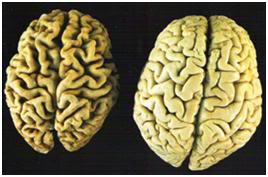 Figure 6: The loss of libido and the transformation of the person from libertine to prude is primarily as function of the degeneration of the brain associated with “normal healthy” aging.
Figure 6: The loss of libido and the transformation of the person from libertine to prude is primarily as function of the degeneration of the brain associated with “normal healthy” aging.
